- Types of Sailboats
- Parts of a Sailboat
- Cruising Boats
- Small Sailboats
- Design Basics
- Sailboats under 30'
- Sailboats 30'-35
- Sailboats 35'-40'
- Sailboats 40'-45'
- Sailboats 45'-50'
- Sailboats 50'-55'
- Sailboats over 55'
- Masts & Spars
- Knots, Bends & Hitches
- The 12v Energy Equation
- Electronics & Instrumentation
- Build Your Own Boat
- Buying a Used Boat
- Choosing Accessories
- Living on a Boat
- Cruising Offshore
- Sailing in the Caribbean
- Anchoring Skills
- Sailing Authors & Their Writings
- Mary's Journal
- Nautical Terms
- Cruising Sailboats for Sale
- List your Boat for Sale Here!
- Used Sailing Equipment for Sale
- Sell Your Unwanted Gear
- Sailing eBooks: Download them here!
- Your Sailboats
- Your Sailing Stories
- Your Fishing Stories
- Advertising
- What's New?
- Chartering a Sailboat
- Running Rigging

Sailboat Rigging: Part 2 - Running Rigging
Sailboat rigging can be described as being either running rigging which is adjustable and controls the sails - or standing rigging, which fixed and is there to support the mast. And there's a huge amount of it on the average cruising boat...
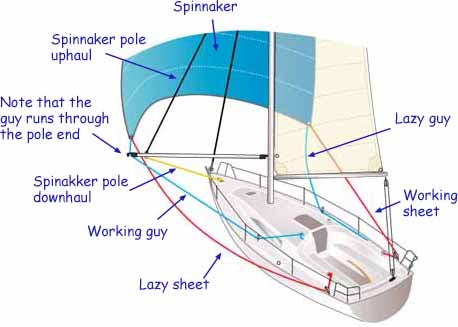
- Port and starboard sheets for the jib, plus two more for the staysail (in the case of a cutter rig) plus a halyard for each - that's 6 separate lines;
- In the case of a cutter you'll need port and starboard runners - that's 2 more;
- A jib furling line - 1 more;
- An up-haul, down-haul and a guy for the whisker pole - 3 more;
- A tackline, sheet and halyard for the cruising chute if you have one - another 3;
- A mainsheet, halyard, kicker, clew outhaul, topping lift and probably three reefing pennants for the mainsail (unless you have an in-mast or in-boom furling system) - 8 more.
Total? 23 separate lines for a cutter-rigged boat, 18 for a sloop. Either way, that's a lot of string for setting and trimming the sails.
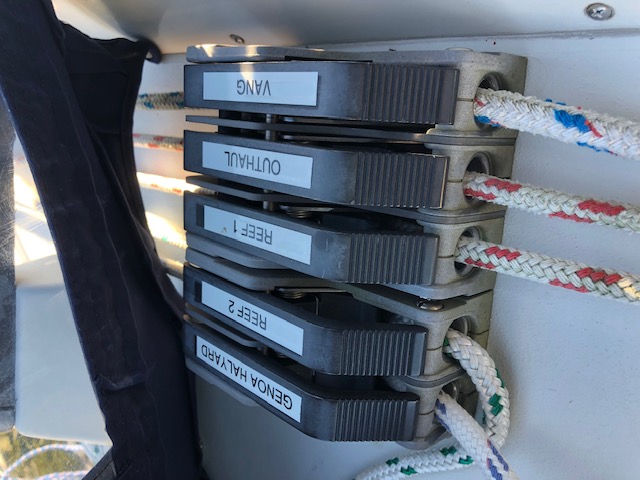
Many skippers prefer to have all running rigging brought back to the cockpit - clearly a safer option than having to operate halyards and reefing lines at the mast. The downside is that the turning blocks at the mast cause friction and associated wear and tear on the lines.
The Essential Properties of Lines for Running Rigging
It's often under high load, so it needs to have a high tensile strength and minimal stretch.
It will run around blocks, be secured in jammers and self-tailing winches and be wrapped around cleats, so good chafe resistance is essential.
Finally it needs to be kind to the hands so a soft pliable line will be much more pleasant to use than a hard rough one.
Not all running rigging is highly stressed of course; lines for headsail roller reefing and mainsail furling systems are comparatively lightly loaded, as are mainsail jiffy reefing pennants, single-line reefing systems and lazy jacks .
But a fully cranked-up sail puts its halyard under enormous load. Any stretch in the halyard would allow the sail to sag and loose its shape.
It used to be that wire halyards with spliced-on rope tails to ease handling were the only way of providing the necessary stress/strain properties for halyards.
Thankfully those days are astern of us - running rigging has moved on a great deal in recent years, as have the winches, jammers and other hardware associated with it.
Modern Materials
Ropes made from modern hi-tech fibres such as Spectra or Dyneema are as strong as wire, lighter than polyester ropes and are virtually stretch free. It's only the core that is made from the hi-tech material; the outer covering is abrasion and UV resistant braided polyester.
But there are a few issues with them:~
- They don't like being bent through a tight radius. A bowline or any other knot will reduce their strength significantly;
- For the same reason, sheaves must have a diameter of at least eight times the diameter of the line;
- Splicing securely to shackles or other rigging hardware is difficult to achieve, as it's slippery stuff. Best to get these done by a professional rigger...
- As you may have guessed, it's expensive stuff!
My approach on Alacazam is to use Dyneema cored line for all applications that are under load for long periods of time - the jib halyard, staysail halyard, main halyard, spinnaker halyard, kicking strap and checkstays - and pre-stretched polyester braid-on-braid line for all other running rigging applications.
Approximate Line Diameters for Running Rigging
But note the word 'approximate'. More precise diameters can only be determined when additional data regarding line material, sail areas, boat type and safety factors are taken into consideration.
Length of boat
Spinnaker guys
Boom Vang and preventers
Spinnaker sheet
Genoa sheet
Main halyard
Genoa / Jib halyard
Spinnaker halyard
Pole uphaul
Pole downhaul
Reefing pennants
Lengthwise it will of course depend on the layout of the boat, the height of the mast and whether it's a fractional or masthead rig - and if you want to bring everything back to the cockpit...
Read more about Reefing and Sail Handling...
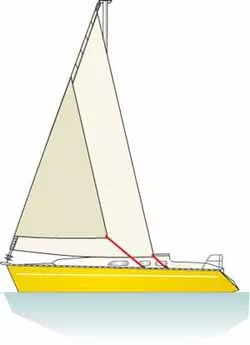
Headsail Roller Reefing Systems Can Jam If Not Set Up Correctly
When headsail roller reefing systems jam there's usually just one reason for it. This is what it is, and here's how to prevent it from happening...
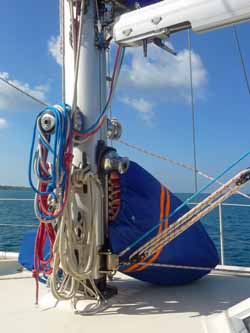
Single Line Reefing; the Simplest Way to Pull a Slab in the Mainsail
Before going to the expense of installing an in-mast or in-boom mainsail roller reefing systems, you should take a look at the simple, dependable and inexpensive single line reefing system
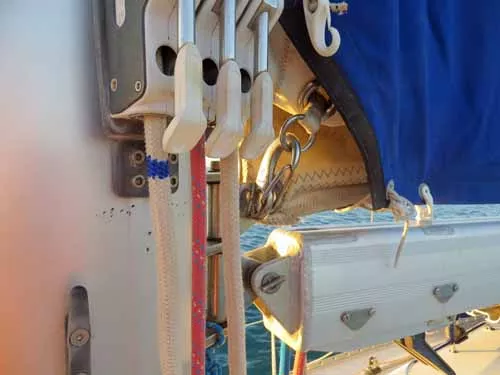
Is Jiffy Reefing the simplest way to reef your boat's mainsail?
Nothing beats the jiffy reefing system for simplicity and reliability. It may have lost some of its popularity due to expensive in mast and in boom reefing systems, but it still works!
Recent Articles
A Hunter Passage 42 for Sale
Jul 16, 24 01:41 PM
The Wauquiez Centurion 40 Sailboat
Jul 15, 24 04:50 AM
The Elan 431 Sailboat
Jul 13, 24 03:03 AM
Here's where to:
- Find Used Sailboats for Sale...
- Find Used Sailing Gear for Sale...
- List your Sailboat for Sale...
- List your Used Sailing Gear...
Our eBooks...

A few of our Most Popular Pages...

Copyright © 2024 Dick McClary Sailboat-Cruising.com

Beginner’s Guide: How To Rig A Sailboat – Step By Step Tutorial
Alex Morgan
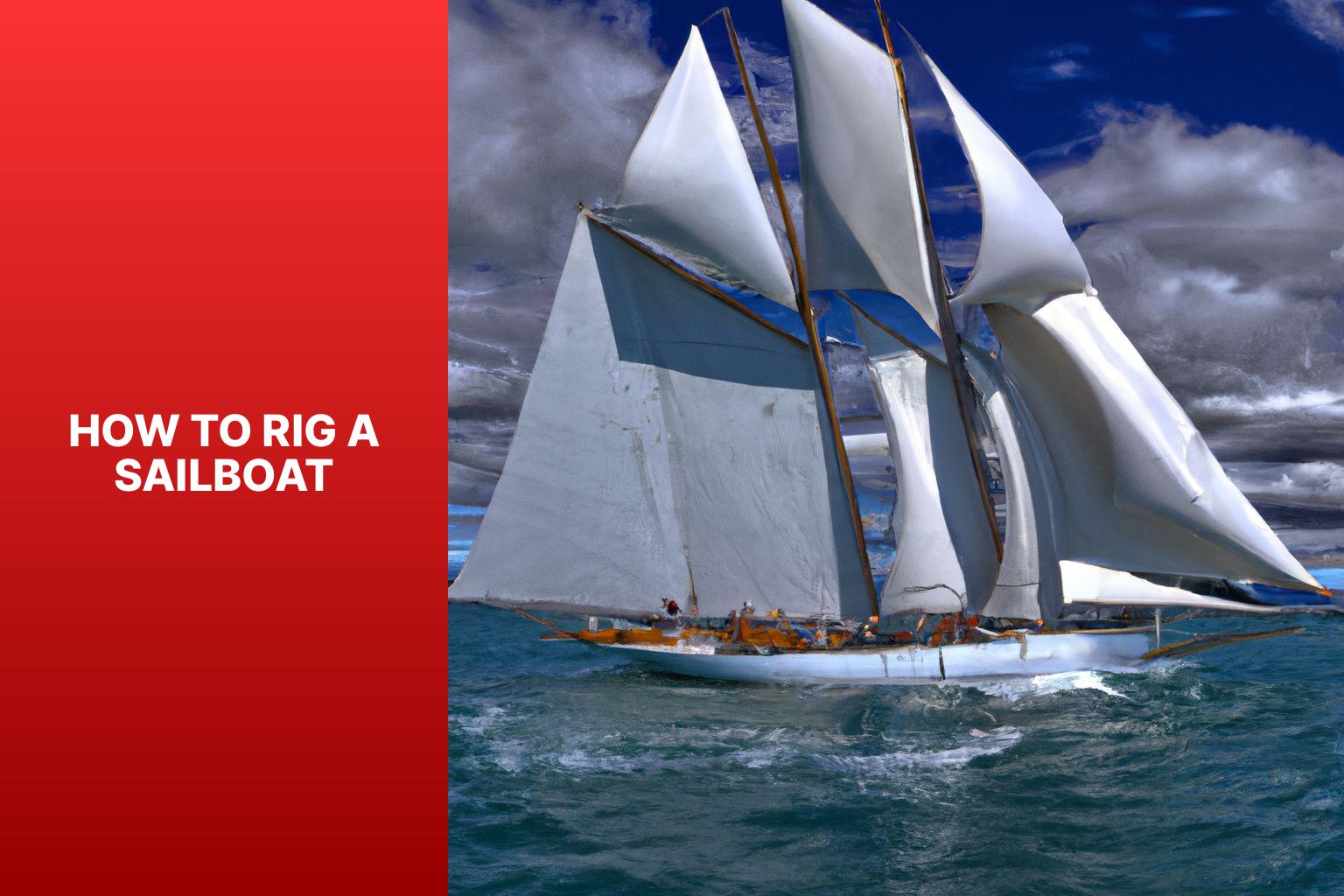
Rigging a sailboat is a crucial process that ensures the proper setup and functioning of a sailboat’s various components. Understanding the process and components involved in rigging is essential for any sailor or boat enthusiast. In this article, we will provide a comprehensive guide on how to rig a sailboat.
Introduction to Rigging a Sailboat
Rigging a sailboat refers to the process of setting up the components that enable the sailboat to navigate through the water using wind power. This includes assembling and positioning various parts such as the mast, boom, standing rigging, running rigging, and sails.
Understanding the Components of a Sailboat Rigging
Before diving into the rigging process, it is important to have a good understanding of the key components involved. These components include:
The mast is the tall vertical spar that provides vertical support to the sails and holds them in place.
The boom is the horizontal spar that runs along the bottom edge of the sail and helps control the shape and position of the sail.
- Standing Rigging:
Standing rigging consists of the wires and cables that support and stabilize the mast, keeping it upright.
- Running Rigging:
Running rigging refers to the lines and ropes used to control the sails, such as halyards, sheets, and control lines.
Preparing to Rig a Sailboat
Before rigging a sailboat, there are a few important steps to take. These include:
- Checking the Weather Conditions:
It is crucial to assess the weather conditions before rigging a sailboat. Unfavorable weather, such as high winds or storms, can make rigging unsafe.
- Gathering the Necessary Tools and Equipment:
Make sure to have all the necessary tools and equipment readily available before starting the rigging process. This may include wrenches, hammers, tape, and other common tools.
- Inspecting the Rigging Components:
In the upcoming sections of this article, we will provide a step-by-step guide on how to rig a sailboat, as well as important safety considerations and tips to keep in mind. By following these guidelines, you will be able to rig your sailboat correctly and safely, allowing for a smooth and enjoyable sailing experience.
Key takeaway:
- Rigging a sailboat maximizes efficiency: Proper rigging allows for optimized sailing performance, ensuring the boat moves smoothly through the water.
- Understanding sailboat rigging components: Familiarity with the various parts of a sailboat rigging, such as the mast, boom, and standing and running riggings, is essential for effective rigging setup.
- Importance of safety in sailboat rigging: Ensuring safety is crucial during the rigging process, including wearing a personal flotation device, securing loose ends and lines, and being mindful of overhead power lines.
Get ready to set sail and dive into the fascinating world of sailboat rigging! We’ll embark on a journey to understand the various components that make up a sailboat’s rigging. From the majestic mast to the nimble boom , and the intricate standing rigging to the dynamic running rigging , we’ll explore the crucial elements that ensure smooth sailing. Not forgetting the magnificent sail, which catches the wind and propels us forward. So grab your sea legs and let’s uncover the secrets of sailboat rigging together.
Understanding the mast is crucial when rigging a sailboat. Here are the key components and steps to consider:
1. The mast supports the sails and rigging of the sailboat. It is made of aluminum or carbon fiber .
2. Before stepping the mast , ensure that the area is clear and the boat is stable. Have all necessary tools and equipment ready.
3. Inspect the mast for damage or wear. Check for corrosion , loose fittings , and cracks . Address any issues before proceeding.
4. To step the mast , carefully lift it into an upright position and insert the base into the mast step on the deck of the sailboat.
5. Secure the mast using the appropriate rigging and fasteners . Attach the standing rigging , such as shrouds and stays , to the mast and the boat’s hull .
Fact: The mast of a sailboat is designed to withstand wind resistance and the tension of the rigging for stability and safe sailing.
The boom is an essential part of sailboat rigging. It is a horizontal spar that stretches from the mast to the aft of the boat. Constructed with durable yet lightweight materials like aluminum or carbon fiber, the boom provides crucial support and has control over the shape and position of the sail. It is connected to the mast through a boom gooseneck , allowing it to pivot. One end of the boom is attached to the mainsail, while the other end is equipped with a boom vang or kicker, which manages the tension and angle of the boom. When the sail is raised, the boom is also lifted and positioned horizontally by using the topping lift or lazy jacks.
An incident serves as a warning that emphasizes the significance of properly securing the boom. In strong winds, an improperly fastened boom swung across the deck, resulting in damage to the boat and creating a safety hazard. This incident highlights the importance of correctly installing and securely fastening all rigging components, including the boom, to prevent accidents and damage.
3. Standing Rigging
When rigging a sailboat, the standing rigging plays a vital role in providing stability and support to the mast . It consists of several key components, including the mast itself, along with the shrouds , forestay , backstay , and intermediate shrouds .
The mast, a vertical pole , acts as the primary support structure for the sails and the standing rigging. Connected to the top of the mast are the shrouds , which are cables or wires that extend to the sides of the boat, providing essential lateral support .
The forestay is another vital piece of the standing rigging. It is a cable or wire that runs from the top of the mast to the bow of the boat, ensuring forward support . Similarly, the backstay , also a cable or wire, runs from the mast’s top to the stern of the boat, providing important backward support .
To further enhance the rig’s stability , intermediate shrouds are installed. These additional cables or wires are positioned between the main shrouds, as well as the forestay or backstay. They offer extra support , strengthening the standing rigging system.
Regular inspections of the standing rigging are essential to detect any signs of wear, such as fraying or corrosion . It is crucial to ensure that all connections within the rig are tight and secure, to uphold its integrity. Should any issues be identified, immediate attention must be given to prevent accidents or damage to the boat. Prioritizing safety is of utmost importance when rigging a sailboat, thereby necessitating proper maintenance of the standing rigging. This ensures a safe and enjoyable sailing experience.
Note: <p> tags have been kept intact.
4. Running Rigging
Running Rigging
When rigging a sailboat, the running rigging is essential for controlling the sails and adjusting their position. It is important to consider several aspects when dealing with the running rigging.
1. Choose the right rope: The running rigging typically consists of ropes with varying properties such as strength, stretch, and durability. Weather conditions and sailboat size should be considered when selecting the appropriate rope.
2. Inspect and maintain the running rigging: Regularly check for signs of wear, fraying, or damage. To ensure safety and efficiency, replace worn-out ropes.
3. Learn essential knot tying techniques: Having knowledge of knots like the bowline, cleat hitch, and reef knot is crucial for securing the running rigging and adjusting sails.
4. Understand different controls: The running rigging includes controls such as halyards, sheets, and control lines. Familiarize yourself with their functions and proper usage to effectively control sail position and tension.
5. Practice proper sail trimming: Adjusting the tension of the running rigging significantly affects sailboat performance. Mastering sail trimming techniques will help optimize sail shape and maximize speed.
By considering these factors and mastering running rigging techniques, you can enhance your sailing experience and ensure the safe operation of your sailboat.
The sail is the central component of sailboat rigging as it effectively harnesses the power of the wind to propel the boat.
When considering the sail, there are several key aspects to keep in mind:
– Material: Sails are typically constructed from durable and lightweight materials such as Dacron or polyester. These materials provide strength and resistance to various weather conditions.
– Shape: The shape of the sail plays a critical role in its overall performance. A well-shaped sail should have a smooth and aerodynamic profile, which allows for maximum efficiency in capturing wind power.
– Size: The size of the sail is determined by its sail area, which is measured in square feet or square meters. Larger sails have the ability to generate more power, but they require greater skill and experience to handle effectively.
– Reefing: Reefing is the process of reducing the sail’s size to adapt to strong winds. Sails equipped with reefing points allow sailors to decrease the sail area, providing better control in challenging weather conditions.
– Types: There are various types of sails, each specifically designed for different purposes. Common sail types include mainsails, jibs, genoas, spinnakers, and storm sails. Each type possesses its own unique characteristics and is utilized under specific wind conditions.
Understanding the sail and its characteristics is vital for sailors, as it directly influences the boat’s speed, maneuverability, and overall safety on the water.
Getting ready to rig a sailboat requires careful preparation and attention to detail. In this section, we’ll dive into the essential steps you need to take before setting sail. From checking the weather conditions to gathering the necessary tools and equipment, and inspecting the rigging components, we’ll ensure that you’re fully equipped to navigate the open waters with confidence. So, let’s get started on our journey to successfully rigging a sailboat!
1. Checking the Weather Conditions
Checking the weather conditions is crucial before rigging a sailboat for a safe and enjoyable sailing experience. Monitoring the wind speed is important in order to assess the ideal sailing conditions . By checking the wind speed forecast , you can determine if the wind is strong or light . Strong winds can make sailboat control difficult, while very light winds can result in slow progress.
Another important factor to consider is the wind direction . Assessing the wind direction is crucial for route planning and sail adjustment. Favorable wind direction helps propel the sailboat efficiently, making your sailing experience more enjoyable.
In addition to wind speed and direction, it is also important to consider weather patterns . Keep an eye out for impending storms or heavy rain. It is best to avoid sailing in severe weather conditions that may pose a safety risk. Safety should always be a top priority when venturing out on a sailboat.
Another aspect to consider is visibility . Ensure good visibility by checking for fog, haze, or any other conditions that may hinder navigation. Clear visibility is important for being aware of other boats and potential obstacles that may come your way.
Be aware of the local conditions . Take into account factors such as sea breezes, coastal influences, or tidal currents. These local factors greatly affect sailboat performance and safety. By considering all of these elements, you can have a successful and enjoyable sailing experience.
Here’s a true story to emphasize the importance of checking the weather conditions. One sunny afternoon, a group of friends decided to go sailing. Before heading out, they took the time to check the weather conditions. They noticed that the wind speed was expected to be around 10 knots, which was perfect for their sailboat. The wind direction was coming from the northwest, allowing for a pleasant upwind journey. With clear visibility and no approaching storms, they set out confidently, enjoying a smooth and exhilarating sail. This positive experience was made possible by their careful attention to checking the weather conditions beforehand.
2. Gathering the Necessary Tools and Equipment
To efficiently gather all of the necessary tools and equipment for rigging a sailboat, follow these simple steps:
- First and foremost, carefully inspect your toolbox to ensure that you have all of the basic tools such as wrenches, screwdrivers, and pliers.
- Make sure to check if you have a tape measure or ruler available as they are essential for precise measurements of ropes or cables.
- Don’t forget to include a sharp knife or rope cutter in your arsenal as they will come in handy for cutting ropes or cables to the desired lengths.
- Gather all the required rigging hardware including shackles, pulleys, cleats, and turnbuckles.
- It is always prudent to check for spare ropes or cables in case replacements are needed during the rigging process.
- If needed, consider having a sailing knife or marlinspike tool for splicing ropes or cables.
- For rigging a larger sailboat, it is crucial to have a mast crane or hoist to assist with stepping the mast.
- Ensure that you have a ladder or some other means of reaching higher parts of the sailboat, such as the top of the mast.
Once, during the preparation of rigging my sailboat, I had a moment of realization when I discovered that I had forgotten to bring a screwdriver . This unfortunate predicament occurred while I was in a remote location with no nearby stores. Being resourceful, I improvised by utilizing a multipurpose tool with a small knife blade, which served as a makeshift screwdriver. Although it was not the ideal solution, it allowed me to accomplish the task. Since that incident, I have learned the importance of double-checking my toolbox before commencing any rigging endeavor. This practice ensures that I have all of the necessary tools and equipment, preventing any unexpected surprises along the way.
3. Inspecting the Rigging Components
Inspecting the rigging components is essential for rigging a sailboat safely. Here is a step-by-step guide on inspecting the rigging components:
1. Visually inspect the mast, boom, and standing rigging for damage, such as corrosion, cracks, or loose fittings.
2. Check the tension of the standing rigging using a tension gauge. It should be within the recommended range from the manufacturer.
3. Examine the turnbuckles, clevis pins, and shackles for wear or deformation. Replace any damaged or worn-out hardware.
4. Inspect the running rigging, including halyards and sheets, for fraying, signs of wear, or weak spots. Replace any worn-out lines.
5. Check the sail for tears, wear, or missing hardware such as grommets or luff tape.
6. Pay attention to the connections between the standing rigging and the mast. Ensure secure connections without any loose or missing cotter pins or rigging screws.
7. Inspect all fittings, such as mast steps, spreader brackets, and tangs, to ensure they are securely fastened and in good condition.
8. Conduct a sea trial to assess the rigging’s performance and make necessary adjustments.
Regularly inspecting the rigging components is crucial for maintaining the sailboat’s rigging system’s integrity, ensuring safe sailing conditions, and preventing accidents or failures at sea.
Once, I went sailing on a friend’s boat without inspecting the rigging components beforehand. While at sea, a sudden gust of wind caused one of the shrouds to snap. Fortunately, no one was hurt, but we had to cut the sail loose and carefully return to the marina. This incident taught me the importance of inspecting the rigging components before sailing to avoid unforeseen dangers.
Step-by-Step Guide on How to Rig a Sailboat
Get ready to set sail with our step-by-step guide on rigging a sailboat ! We’ll take you through the process from start to finish, covering everything from stepping the mast to setting up the running rigging . Learn the essential techniques and tips for each sub-section, including attaching the standing rigging and installing the boom and sails . Whether you’re a seasoned sailor or a beginner, this guide will have you ready to navigate the open waters with confidence .
1. Stepping the Mast
To step the mast of a sailboat, follow these steps:
1. Prepare the mast: Position the mast near the base of the boat.
2. Attach the base plate: Securely fasten the base plate to the designated area on the boat.
3. Insert the mast step: Lower the mast step into the base plate and align it with the holes or slots.
4. Secure the mast step: Use fastening screws or bolts to fix the mast step in place.
5. Raise the mast: Lift the mast upright with the help of one or more crew members.
6. Align the mast: Adjust the mast so that it is straight and aligned with the boat’s centerline.
7. Attach the shrouds: Connect the shrouds to the upper section of the mast, ensuring proper tension.
8. Secure the forestay: Attach the forestay to the bow of the boat, ensuring it is securely fastened.
9. Final adjustments: Check the tension of the shrouds and forestay, making any necessary rigging adjustments.
Following these steps ensures that the mast is properly stepped and securely in place, allowing for a safe and efficient rigging process. Always prioritize safety precautions and follow manufacturer guidelines for your specific sailboat model.
2. Attaching the Standing Rigging
To attach the standing rigging on a sailboat, commence by preparing the essential tools and equipment, including wire cutters, crimping tools, and turnbuckles.
Next, carefully inspect the standing rigging components for any indications of wear or damage.
After inspection, fasten the bottom ends of the shrouds and stays to the chainplates on the deck.
Then, securely affix the top ends of the shrouds and stays to the mast using adjustable turnbuckles .
To ensure proper tension, adjust the turnbuckles accordingly until the mast is upright and centered.
Utilize a tension gauge to measure the tension in the standing rigging, aiming for around 15-20% of the breaking strength of the rigging wire.
Double-check all connections and fittings to verify their security and proper tightness.
It is crucial to regularly inspect the standing rigging for any signs of wear or fatigue and make any necessary adjustments or replacements.
By diligently following these steps, you can effectively attach the standing rigging on your sailboat, ensuring its stability and safety while on the water.
3. Installing the Boom and Sails
To successfully complete the installation of the boom and sails on a sailboat, follow these steps:
1. Begin by securely attaching the boom to the mast. Slide it into the gooseneck fitting and ensure it is firmly fastened using a boom vang or another appropriate mechanism.
2. Next, attach the main sail to the boom. Slide the luff of the sail into the mast track and securely fix it in place using sail slides or cars.
3. Connect the mainsheet to the boom. One end should be attached to the boom while the other end is connected to a block or cleat on the boat.
4. Proceed to attach the jib or genoa. Make sure to securely attach the hanks or furler line to the forestay to ensure stability.
5. Connect the jib sheets. One end of each jib sheet should be attached to the clew of the jib or genoa, while the other end is connected to a block or winch on the boat.
6. Before setting sail, it is essential to thoroughly inspect all lines and connections. Ensure that they are properly tensioned and that all connections are securely fastened.
During my own experience of installing the boom and sails on my sailboat, I unexpectedly encountered a strong gust of wind. As a result, the boom began swinging uncontrollably, requiring me to quickly secure it to prevent any damage. This particular incident served as a vital reminder of the significance of properly attaching and securing the boom, as well as the importance of being prepared for unforeseen weather conditions while rigging a sailboat.
4. Setting Up the Running Rigging
Setting up the running rigging on a sailboat involves several important steps. First, attach the halyard securely to the head of the sail. Then, connect the sheets to the clew of the sail. If necessary, make sure to secure the reefing lines . Attach the outhaul line to the clew of the sail and connect the downhaul line to the tack of the sail. It is crucial to ensure that all lines are properly cleated and organized. Take a moment to double-check the tension and alignment of each line. If you are using a roller furling system, carefully wrap the line around the furling drum and securely fasten it. Perform a thorough visual inspection of the running rigging to check for any signs of wear or damage. Properly setting up the running rigging is essential for safe and efficient sailing. It allows for precise control of the sail’s position and shape, ultimately optimizing the boat’s performance on the water.
Safety Considerations and Tips
When it comes to rigging a sailboat, safety should always be our top priority. In this section, we’ll explore essential safety considerations and share some valuable tips to ensure smooth sailing. From the importance of wearing a personal flotation device to securing loose ends and lines, and being cautious around overhead power lines, we’ll equip you with the knowledge and awareness needed for a safe and enjoyable sailing experience. So, let’s set sail and dive into the world of safety on the water!
1. Always Wear a Personal Flotation Device
When rigging a sailboat, it is crucial to prioritize safety and always wear a personal flotation device ( PFD ). Follow these steps to properly use a PFD:
- Select the appropriate Coast Guard-approved PFD that fits your size and weight.
- Put on the PFD correctly by placing your arms through the armholes and securing all the straps for a snug fit .
- Adjust the PFD for comfort , ensuring it is neither too tight nor too loose, allowing freedom of movement and adequate buoyancy .
- Regularly inspect the PFD for any signs of wear or damage, such as tears or broken straps, and replace any damaged PFDs immediately .
- Always wear your PFD when on or near the water, even if you are a strong swimmer .
By always wearing a personal flotation device and following these steps, you will ensure your safety and reduce the risk of accidents while rigging a sailboat. Remember, prioritize safety when enjoying water activities.
2. Secure Loose Ends and Lines
Inspect lines and ropes for frayed or damaged areas. Secure loose ends and lines with knots or appropriate cleats or clamps. Ensure all lines are properly tensioned to prevent loosening during sailing. Double-check all connections and attachments for security. Use additional safety measures like extra knots or stopper knots to prevent line slippage.
To ensure a safe sailing experience , it is crucial to secure loose ends and lines properly . Neglecting this important step can lead to accidents or damage to the sailboat. By inspecting, securing, and tensioning lines , you can have peace of mind knowing that everything is in place. Replace or repair any compromised lines or ropes promptly. Securing loose ends and lines allows for worry-free sailing trips .
3. Be Mindful of Overhead Power Lines
When rigging a sailboat, it is crucial to be mindful of overhead power lines for safety. It is important to survey the area for power lines before rigging the sailboat. Maintain a safe distance of at least 10 feet from power lines. It is crucial to avoid hoisting tall masts or long antenna systems near power lines to prevent contact. Lower the mast and tall structures when passing under a power line to minimize the risk of contact. It is also essential to be cautious in areas where power lines run over the water and steer clear to prevent accidents.
A true story emphasizes the importance of being mindful of overhead power lines. In this case, a group of sailors disregarded safety precautions and their sailboat’s mast made contact with a low-hanging power line, resulting in a dangerous electrical shock. Fortunately, no serious injuries occurred, but it serves as a stark reminder of the need to be aware of power lines while rigging a sailboat.
Some Facts About How To Rig A Sailboat:
- ✅ Small sailboat rigging projects can improve sailing performance and save money. (Source: stingysailor.com)
- ✅ Rigging guides are available for small sailboats, providing instructions and tips for rigging. (Source: westcoastsailing.net)
- ✅ Running rigging includes lines used to control and trim the sails, such as halyards and sheets. (Source: sailingellidah.com)
- ✅ Hardware used in sailboat rigging includes winches, blocks, and furling systems. (Source: sailingellidah.com)
- ✅ A step-by-step guide can help beginners rig a small sailboat for sailing. (Source: tripsavvy.com)
Frequently Asked Questions
1. how do i rig a small sailboat.
To rig a small sailboat, follow these steps: – Install or check the rudder, ensuring it is firmly attached. – Attach or check the tiller, the long steering arm mounted to the rudder. – Attach the jib halyard by connecting the halyard shackle to the head of the sail and the grommet in the tack to the bottom of the forestay. – Hank on the jib by attaching the hanks of the sail to the forestay one at a time. – Run the jib sheets by tying or shackling them to the clew of the sail and running them back to the cockpit. – Attach the mainsail by spreading it out and attaching the halyard shackle to the head of the sail. – Secure the tack, clew, and foot of the mainsail to the boom using various lines and mechanisms. – Insert the mainsail slugs into the mast groove, gradually raising the mainsail as the slugs are inserted. – Cleat the main halyard and lower the centerboard into the water. – Raise the jib by pulling down on the jib halyard and cleating it on the other side of the mast. – Tighten the mainsheet and one jibsheet to adjust the sails and start moving forward.
2. What are the different types of sailboat rigs?
Sailboat rigs can be classified into three main types: – Sloop rig: This rig has a single mast with a mainsail and a headsail, typically a jib or genoa. – Cutter rig: This rig has two headsails, a smaller jib or staysail closer to the mast, and a larger headsail, usually a genoa, forward of it, alongside a mainsail. – Ketch rig: This rig has two masts, with the main mast taller than the mizzen mast. It usually has a mainsail, headsail, and a mizzen sail. Each rig has distinct characteristics and is suitable for different sailing conditions and preferences.
3. What are the essential parts of a sailboat?
The essential parts of a sailboat include: – Mast: The tall vertical spar that supports the sails. – Boom: The horizontal spar connected to the mast, which extends outward and supports the foot of the mainsail. – Rudder: The underwater appendage that steers the boat. – Centerboard or keel: A retractable or fixed fin-like structure that provides stability and prevents sideways drift. – Sails: The fabric structures that capture the wind’s energy to propel the boat. – Running rigging: The lines or ropes used to control the sails and sailing equipment. – Standing rigging: The wires and cables that support the mast and reinforce the spars. These are the basic components necessary for the functioning of a sailboat.
4. What is a spinnaker halyard?
A spinnaker halyard is a line used to hoist and control a spinnaker sail. The spinnaker is a large, lightweight sail that is used for downwind sailing or reaching in moderate to strong winds. The halyard attaches to the head of the spinnaker and is used to raise it to the top of the mast. Once hoisted, the spinnaker halyard can be adjusted to control the tension and shape of the sail.
5. Why is it important to maintain and replace worn running rigging?
It is important to maintain and replace worn running rigging for several reasons: – Safety: Worn or damaged rigging can compromise the integrity and stability of the boat, posing a safety risk to both crew and vessel. – Performance: Worn rigging can affect the efficiency and performance of the sails, diminishing the boat’s speed and maneuverability. – Reliability: Aging or worn rigging is more prone to failure, which can lead to unexpected problems and breakdowns. Regular inspection and replacement of worn running rigging is essential to ensure the safe and efficient operation of a sailboat.
6. Where can I find sailboat rigging books or guides?
There are several sources where you can find sailboat rigging books or guides: – Online: Websites such as West Coast Sailing and Stingy Sailor offer downloadable rigging guides for different sailboat models. – Bookstores: Many bookstores carry a wide selection of boating and sailing books, including those specifically focused on sailboat rigging. – Sailing schools and clubs: Local sailing schools or yacht clubs often have resources available for learning about sailboat rigging. – Manufacturers: Some sailboat manufacturers, like Hobie Cat and RS Sailing, provide rigging guides for their specific sailboat models. Consulting these resources can provide valuable information and instructions for rigging your sailboat properly.
About the author
Leave a Reply Cancel reply
Your email address will not be published. Required fields are marked *
Save my name, email, and website in this browser for the next time I comment.
Latest posts

The history of sailing – from ancient times to modern adventures
History of Sailing Sailing is a time-honored tradition that has evolved over millennia, from its humble beginnings as a means of transportation to a beloved modern-day recreational activity. The history of sailing is a fascinating journey that spans cultures and centuries, rich in innovation and adventure. In this article, we’ll explore the remarkable evolution of…

Sailing Solo: Adventures and Challenges of Single-Handed Sailing
Solo Sailing Sailing has always been a pursuit of freedom, adventure, and self-discovery. While sailing with a crew is a fantastic experience, there’s a unique allure to sailing solo – just you, the wind, and the open sea. Single-handed sailing, as it’s often called, is a journey of self-reliance, resilience, and the ultimate test of…

Sustainable Sailing: Eco-Friendly Practices on the boat
Eco Friendly Sailing Sailing is an exhilarating and timeless way to explore the beauty of the open water, but it’s important to remember that our oceans and environment need our protection. Sustainable sailing, which involves eco-friendly practices and mindful decision-making, allows sailors to enjoy their adventures while minimizing their impact on the environment. In this…
- AROUND THE SAILING WORLD
- BOAT OF THE YEAR
- Email Newsletters
- America’s Cup
- St. Petersburg
- Caribbean Championship
- Boating Safety

Simple Ways to Optimize Running Rigging
- By Erik Shampain
- December 6, 2022
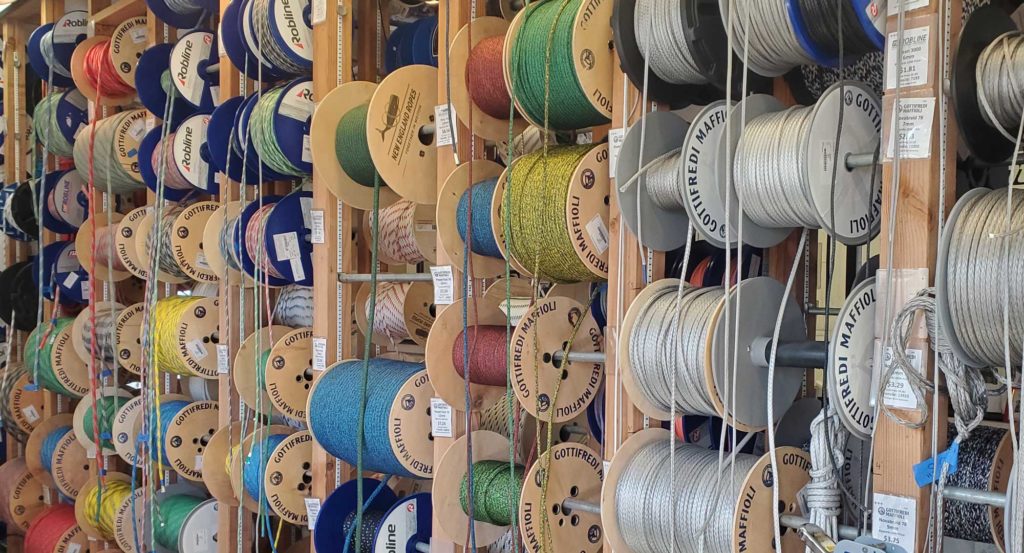
It’s easy to underestimate the benefits of good running rigging. There are many rope products on the market, and there is a time and a place for most of them. Let’s take a look at lines that need the most attention and why, as well as basic rules for using low-stretch line, using lightweight or tapered line where most beneficial and using rope that is easy to work with.
Let’s start up front with the headsail halyard. Luff tension greatly affects shape and thus performance of the jib or genoa, so having a halyard that is as low-stretch as possible is paramount. Saving a little weight aloft is also key, so find a lightweight rope as well. It’s a little against the norm, but for club racing boats that aren’t tapering their halyards, I really like some of the Vectran-cored ropes. Products like Samson’s Validator and New England Ropes V-100 are easy on the hands and easy to splice. For a little more grand-prixed tapered halyard, talk to our local rigger about using a DUX core, or other heat-set Dyneema, with a Technora-based cover. Lately, I’ve been using a lot of Marlow’s D12 MAX 78 and 99. Tapering the halyard saves weight aloft as well. I like soft shackles for jib halyards. There, weight savings aloft generally outweighs the little extra time a bowman needs to attach the sail. This is especially true in sprit boats where the jib is rarely removed from the headstay.
Pro Tip: When not racing, use a halyard leader to pull the halyards to the top of the mast, getting the tapered section out of the sun. For extra protection, put all the halyard tails into an old duffle bag at the base of the mast when not in use.
For jib sheets, I follow the same low-stretch rule as the jib halyard. I don’t want the jib sheet to stretch at all when a puff hits. On boats with overlapping genoas, I don’t generally recommend tapering the line because by the time the genoa is trimmed all the way in, the clew is really close to the block. On boats with non-overlapping jibs, tapering is an easy way to save a little weigh. Plus, the smaller core size runs through across the boat more easily in tacks. I’ve been using soft shackles on the jib or genoa sheets for a while now, mostly because they don’t beat the mast up during tacks. There also a bit “softer” when they hit you.
What about jib lead adjusters? There are a couple of approaches here. Some believe a little stretch is okay, as it allows the lead to rock aft a couple of millimeters in puffs, which twists the top of the jib off slightly. This can be fast as it helps the boat transition through puffs and lulls. I am a fan of this as long as it isn’t too stretchy. I use low-stretch Dyneema for the gross part of the purchase and then a friendlier-on-the-hands rope for the fine tune side, the part that is being handled. Samson Warpspeed or New England Enduro Braid work well.
Spinnaker sheets are a fun one. They should be relatively low-stretch but not necessarily the lowest stretch. I’ve found that near-zero stretch lines can wreak havoc on people and hardware when flogging or when the chute is collapsing. They have to be easy on the hands, as they are the most moved sheets on the boat, and they should be tapered as far as you can get away with. Tapering saves weigh, which is very important in keeping the spinnaker clew lifting up, especially in light air when sails want to droop. Again, Samson Warpseed and New England Enduro braid are good. For boats with grinders or even small boats with no winches, a cover that is a little grippier or stronger is good. Most Technora-based covers work well for this purpose.
Pro Tip No. 2: On boats with asymmetric spinnakers I like to connect the ‘Y’ sheet with a soft shackle that also goes to the spinnaker. This saves weight. I sew a Velcro strip around one part of the shackle (see picture) so that the soft shackle stays with the ‘Y’ sheet when open. This is beneficial when you have to quickly disconnect or re-run a sheet, replace one sheet, or even quickly replace a soft shackle. On most boats I will keep one spare spinnaker sheet with soft shackle down below as a spare side, changing sheet, or code zero sheet. On boats with a symmetric spinnaker, we’ll splice the spinnaker sheet to the afterguy shackle to save weight in the clew.
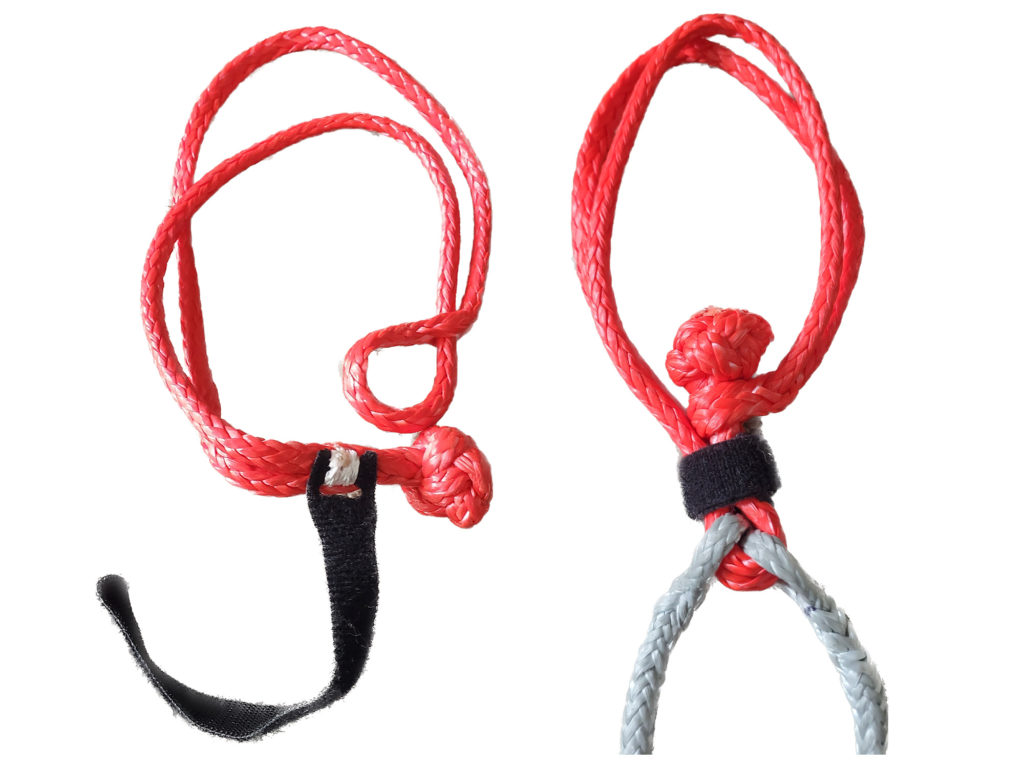
The spinnaker halyard has a couple of more options. For halyards supporting code zeros, zero stretch is important. The same principals we used when talking about the jib halyard apply here. For boats without code zeros, I like a little softer halyard with a touch of give. Those tend to run though sheaves better without kinking. Enduro and Warpseed are good for these applications. Most bowmen prefer a shackle that is quick and easy to open. Since a happy bowman is a good thing, I will generally use an appropriately sized Tylaska shackle or dogbone style shackle for those halyards
For symmetric spinnaker boats, the afterguy must be very low stretch line. I go back to products like covered Vectran for club-level sheets. I also find that afterguys generally last longer if I don’t taper them. When the pole is squared back, the afterguys often run pretty hard across the lifelines, producing a fair amount of chafe. Covered lines help minimize that.
For tack lines on asymmetric boats, I like matching spinnaker halyard material on club-level boats and using low-stretch heat-set Dyneema cores with a chafe resistant cover for grand prix and sportboats.
Like the headsail halyard, a near-zero stretch main halyard is also important. For me the same line applications apply. Keep the mainsail head at full hoist at all costs. I will often match the material I use for main and jib halyards.
It is most important that the main sheet sit in the winch jaws well and tail perfectly. This is a strict combination of sizing and pliability. I’ve found that the New England Ropes Enduro braid and the Samson Warpspeed II work well for club-level boats with and without winches. For a slightly longer lasting product with some chafe resistance, try any manufacturer’s Technora-based covered line.
The most under-appreciated and least thought about rope on a boat always seems to be the outhaul. The last thing you want when the wind comes up is for your mainsail to get fuller. Spend some time here and use very low-stretch rope. Most heat-set Dyneemas will work great for the gross tune side of the purchase.
Pro Tip No. 3: Minimizing the last purchase of an outhaul greatly increases the ease with which it can be pulled on or eased out. For example, you could have a 6-to-1 to one pulling a 2-to-1, pulling a 2-to-1 and then to the sail for a 24-to-1. Or, better yet, you could have a 4-to-1 pulling a 3-to-1, pulling a 2-to-1 for a 24-to-1 as well. The latter example will work better. Trust me. I’m a doctor . . . sort of. We built an outhaul like this on a SC50. I can pull it on upwind in heavy air with little problem. On the flip side, in light air downwind, it eases just as well. In fact, if memory serves me right, we did a 3-to-1 in the end rather than the 4-to-1 for a total of 18-to-1 and it worked well.
Runners and backstays should have extremely low stretch. A pumping mast and sagging forestay in breeze isn’t fast. Runner tails, like the mainsheet, should perfectly fit the winch and tail easily without kinking.
With so many options readily on the market now, it can be very confusing. I always recommend contacting your local rigger if you have any questions at all about what rope is right for you. They’ll get you pulling in the right direction.
- More: cordage , running rigging , sailboat gear

Reproofing May Be Required
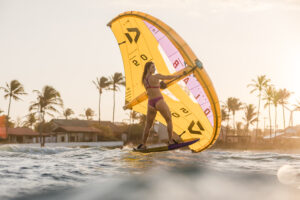
Wingfoiling Gear: A Beginner’s Guide
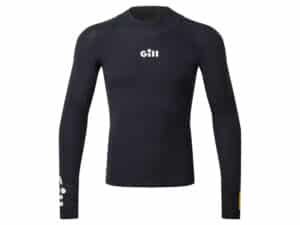
Suiting Up with Gill’s ZenTherm 2.0

Gill Verso Lite Smock Keeps it Simple

Black Foils Pad Season Lead with SailGP New York Win

Widnall Prize Announced for Helly Hansen Sailing World Regatta at Marblehead Race Week
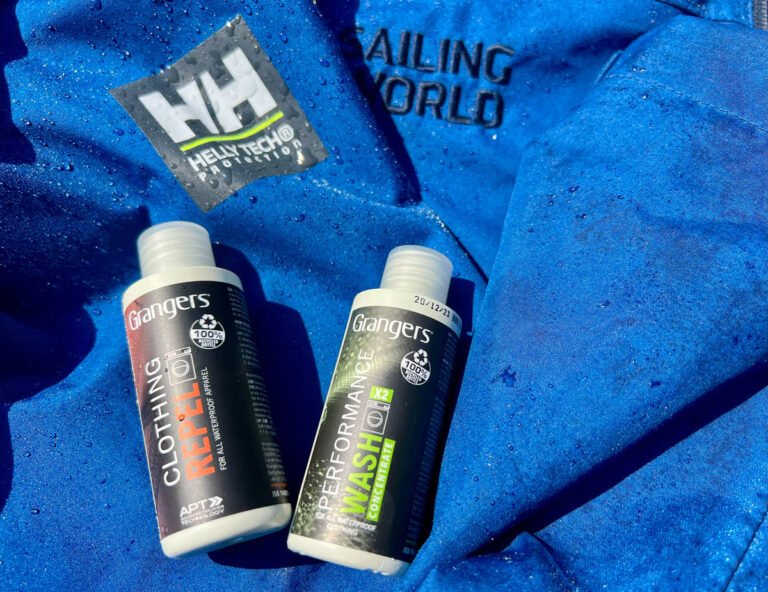
Sagamore Ridealong in Chicago

- Digital Edition
- Customer Service
- Privacy Policy
- Cruising World
- Sailing World
- Salt Water Sportsman
- Sport Fishing
- Wakeboarding
Running Rigging on a Sailboat: Essential Components and Maintenance Tips
by Emma Sullivan | Aug 8, 2023 | Sailboat Maintenance

Short answer running rigging on a sailboat:
Running rigging refers to the ropes and lines used for controlling the sails and other movable parts on a sailboat. It includes halyards, sheets, braces, and control lines. Properly rigged running rigging is essential for efficient sail handling and maneuvering of the boat.
Understanding Running Rigging on a Sailboat: How to Get Started
Title: Deciphering the Intricacies of Running Rigging on a Sailboat: An Enlightened Journey Begins!
Introduction: Ah, the allure of sailing! Picture yourself gracefully gliding across sun-kissed waters, propelled solely by the power of the wind . If you’re new to this mesmerizing world, it’s crucial to understand every aspect – including running rigging. Fear not, fellow adventurer! This comprehensive guide will unravel the mysteries surrounding running rigging and equip you with valuable knowledge to embark upon your own nautical odyssey.
1. The Foundations: What is Running Rigging? Running rigging encompasses all the ropes and lines aboard a sailboat that are used to control sails and their systems. Think of it as a symphony conductor guiding each instrument precisely when they are needed. Understanding its components requires delving into various key elements.
2. The Halyards: Hoisting Your Sails with Elegance Halyards form an integral part of running rigging by facilitating the raising and lowering of sails effortlessly. These vital maneuvering aids connect from the masthead down to specific positions where they secure each sail precisely at one end while granting sailors control at their opposite extremity.
3. Sheets & Controls: Directing Your Power Source Next up in our deconstruction are sheets and controls – essential components for controlling sails’ angles based on wind direction. By cunningly pulling or easing these lines, you can swiftly adjust your sails’ positioning according to weather shifts, resulting in optimal performance .
4. Cleats & Winches: From Taming Lines to Seizing Moments Even Hercules would yield to cleats and winches when taming robust ropes! Cleats serve as steadfast anchors onto which lines can be temporarily secured, providing necessary stability during navigation’s turbulent moments. Winches, on the other hand, offer mechanical assistance by efficiently winding or unwinding lines using a drum mechanism – a sailor’s secret weapon for effortlessly controlling lines under high tension.
5. Blocks & Pulleys: The Silent Workhorses Up Above Blocks and pulleys, hidden amongst the chaos of running rigging, serve as silent heroes deserving recognition. These nifty devices allow lines to redirect their path efficiently, minimizing friction while maximizing mechanical advantage. Imagine them as your trusty allies, ensuring smooth adjustments without burdening you with unnecessary strain.
6. Mainsail Furling Systems: Embracing Elegance in Simplicity To master running rigging effectively, one must grasp the concept of mainsail furling systems. These mechanisms enable swift and straightforward reefing or unfurling of the mainsail using dedicated ropes or electrically-powered systems. By harnessing this technology correctly, you’ll unlock newfound ease in sailing endeavors.
Conclusion: Congratulations! You’ve delved into the intricate world of running rigging on a sailboat and emerged more enlightened than ever before. As you embark upon your maritime journey armed with this invaluable knowledge, remember that practice leads to mastery. Understanding how these distinct elements harmonize will transform you into a maestro, skillfully orchestrating every aspect of your sailing adventure with grace and finesse. Bon voyage!
A Step-by-Step Guide to Setting Up Running Rigging on a Sailboat
Title: Sailing with Confidence: A Masterclass on Setting Up Running Rigging
Introduction:
Embarking on the open sea , feeling the wind against your face as you glide through the water, there’s no greater thrill than sailing. However, to truly harness the power of the wind and have a seamless experience, it is essential to understand how to set up your running rigging. In this comprehensive guide, we will take you through each step of this crucial process, equipping you with the knowledge and confidence necessary for smooth sailing adventures.
1. Assessing Your Needs: The Foundation for Success
Before diving into the nitty-gritty details of setting up your running rigging, it’s important to assess your specific needs according to your sailboat’s design and intended use. Factors such as boat size, mast height, and sail types play a significant role in determining which rigging configurations will work best for you.
2. Selecting Materials: Optimal Performance, Durability & Safety
Choosing suitable materials for running rigging is paramount to ensure reliable performance while maintaining the safety of both crew and vessel. From strong yet lightweight synthetic fibers like Dyneema or Spectra to traditional options such as polyester or nylon, understanding their properties and appropriate applications is essential in making informed decisions.
3. Understanding Key Terminology: Speaking Sailors’ Language
Like any specialized field, sailing has its own set of terminology that can feel overwhelming at first. Fear not! We’ll guide you through key terms such as halyards (hoisting lines), sheets (lines controlling sails), reefing lines (to reduce sail area), allowing you to converse confidently with fellow sailors.
4. Anchoring Your Mast: Secure Your Foundation
The process begins by firmly anchoring your mast at its base using a fitting called a mast step or deck collar. This immovable foundation provides stability throughout various sailing conditions while reducing unnecessary strain on all related rigging components .
5. Hoisting the Sails: Halyards & Their Art
To set sail, a crucial step involves hoisting your sails with precision. Correctly attaching halyards to the designated points on the mast and sail, while ensuring proper tension and alignment, will enable you to control raising, lowering, and reefing the sails with ease—an art form in itself.
6. Harnessing the Wind’s Power: Sheets & Trimming
Once your sails are aloft, skillful manipulation of sheets becomes paramount. Understanding how to trim them properly allows you to harness the wind’s power effectively while achieving maximum speed and maneuverability—a true dance between sailor and nature.
7. Streamlining Movement: Fairleads & Blocks
Efficiency is key when it comes to running rigging. By employing fairleads (pulleys) strategically placed around your vessel and appropriately using blocks (pulley combinations), you can minimize friction within your system, allowing for fluid movement with less effort during sail adjustments.
8. Reducing Sail Area: Reefing Lines at the Ready
As conditions change or storms approach, being able to reduce sail area swiftly is essential for safety purposes. Learning how to utilize reefing lines effectively enables you to adapt your sails according to environmental demands without sacrificing control or stability.
9. Fine-Tuning Your Set-Up: Tension & Balance
The final touch lies in adjusting tension throughout your running rigging system to achieve optimal balance and performance. Maintaining proper tension prevents undesirable effects like excessive wrinkles on sails or slack lines that compromise efficiency—fine-tuning that separates amateurs from seasoned sailors.
10. Everyday Maintenance: Caring For Your Rigging
Just as a well-maintained engine ensures peak performance, regularly caring for your running rigging also guarantees smooth operation over time. Simple tasks such as rinsing off saltwater residue or inspecting for wear and tear go a long way in prolonging the life of your rigging and ensuring a safe voyage.
Conclusion:
With this step-by-step guide, you are now equipped with the knowledge needed to set up running rigging on your sailboat like a seasoned sailor. By understanding the essential components, choosing suitable materials, and mastering the techniques necessary for trimming and maintenance, you’ll confidently navigate the open seas while experiencing the true joy of sailing . Bon voyage!
Frequently Asked Questions about Running Rigging on a Sailboat Demystified
Welcome to the world of sailing! If you’re a beginner or even if you’ve been sailing for a while, running rigging can often seem like a complex and confusing topic. But fear not! In this blog post, we are here to demystify all your frequently asked questions about running rigging on a sailboat.
Q: What is running rigging? A: Running rigging refers to all the lines and ropes that control and adjust the sails on a sailboat. It includes halyards, sheets, reefing lines, downhauls, and any other line used to set or trim sails .
Q: Why is running rigging important? A: Running rigging plays a crucial role in controlling the shape and position of the sails, allowing the boat to harness wind power efficiently . Properly adjusted running rigging enables better sail control, improved performance, and increased safety on board.
Q: How many types of running rigging are there? A: There are several types of running rigging found on most sailboats. Some common ones are halyards (used to lift or lower the sails), sheets (used to control the tension and angle of the sails), outhauls (used to adjust the foot of the mainsail), furling lines (used for rolling up or unfurling headsails), and vang systems (used for controlling boom height).
Q: What materials are used in running rigging? A: Traditionally, natural fibers like hemp or manila were used for ropes. However, modern sailboats mostly use synthetic fibers such as polyester or Dyneema due to their durability, low stretching properties, and resistance to UV degradation.
Q: How do I choose the right running rigging for my boat? A: The choice of running rigging depends on various factors such as boat size/type, sailing conditions, intended use, personal preference, and budget. It’s always advisable to consult with a reputable rigging professional who can assess your specific requirements and recommend the appropriate type and diameter of ropes for your boat .
Q: How often should I replace my running rigging? A: The lifespan of running rigging depends on various factors including usage, exposure to sunlight, and regular maintenance. As a general rule of thumb, inspect your running rigging regularly for signs of wear and tear. If you notice any fraying, excessive stretching, or damage, it’s essential to replace the affected lines promptly.
Q: Can I maintain my own running rigging? A: Yes! Regular maintenance is key to prolonging the life of your running rigging. Simple tasks like washing with fresh water after use, removing dirt or salt residue, and storing the lines properly can significantly extend their lifespan. However, if you’re unsure about any specific maintenance tasks or need assistance with more complex issues, it’s best to seek advice from a professional rigger.
Q: Are there any advanced techniques related to running rigging? A: Absolutely! Advanced sailing techniques often involve various adjustments using different lines simultaneously. For example, using barberhaulers to control genoa sheeting angles or implementing cunningham systems for mainsail shape adjustments. These techniques require practice and knowledge but can greatly enhance sail efficiency and boat performance.
Now that we’ve demystified some frequently asked questions about running rigging on a sailboat, we hope you feel more confident in understanding this vital aspect of sailing. Remember that every boat is unique, so investing time in learning about and maintaining your specific running rigging system will undoubtedly pay off in smoother sailing experiences ahead!
Choosing the Right Materials for Your Sailboat’s Running Rigging
When it comes to your sailboat’s running rigging, choosing the right materials can make all the difference in ensuring optimal performance and longevity. But with a plethora of options available, it can be a daunting task. Fear not, for we are here to guide you through this decision-making process, providing you with a detailed professional, witty and clever explanation.
First and foremost, let’s clarify what we mean by “running rigging.” In sailing terms, this refers to all the lines (ropes) used to control the sails and their adjustments while underway. These lines include halyards (used for raising and lowering the sails), sheets (controls the angle and trim of the sails), and various other control lines like reefing lines or vang lines. Each requires specific characteristics based on its purpose.
When considering materials for running rigging, durability is paramount. You want something that can withstand constant exposure to UV rays, saltwater, friction wear, and general wear and tear. One material that stands out in terms of resilience is Dyneema®. This high-performance synthetic fiber boasts an incredible strength-to-weight ratio similar to steel but without the weight or corrosion concerns. Paired with excellent resistance to UV degradation and abrasion resistance properties, Dyneema® offers a long-lasting solution for your running rigging needs.
But hold on! While Dyneema® may seem like an obvious choice, there are other factors to consider as well. For instance, ease of handling plays a significant role in determining which material is right for you. Some sailors prefer traditional materials like polyester or nylon due to their familiar feel and ease of tying knots. However, these materials tend to stretch more under load compared to Dyneema®, which can affect sail shape and overall performance .
To address this issue without compromising on durability or ease of handling completely, manufacturers have developed hybrid rope constructions where different fibers are combined strategically within a single line. For example, a Dyneema® core can be paired with a polyester or Technora cover, harnessing the best of both worlds. This combination provides the strength and low stretch characteristics of Dyneema® while maintaining that traditional feel when handling.
Now, let’s sprinkle in some wit and cleverness as we delve into the importance of reliability. When out on the open seas, you don’t want to be caught off guard by a line failure because you chose an unreliable material. Imagine your excitement as the wind picks up, preparing for an exhilarating sail, only to have your sailing dreams dashed due to a snapped halyard! Trust me; it’s not an experience you’ll find amusing, nor will your crew appreciate your comedic skills at such moments. So, don’t skimp on quality.
To ensure reliability and avoid any unplanned comedy acts on board, investing in well-respected brands known for their commitment to excellence is key. Reputable manufacturers like New England Ropes or Marlow Ropes are popular choices among sailors worldwide. Their rigorous testing processes and innovative designs guarantee performance reliability no matter what Mother Nature throws your way.
We hope this detailed professional, witty and clever explanation has shed some light on choosing the right materials for your sailboat’s running rigging. Remember to consider durability, ease of handling, and reliability when making your decision. And if you’re still unsure or need further assistance—don’t hesitate to reach out to fellow sailors or consult with professionals who can offer personalized advice tailored to your unique sailing style. Happy rigging!
Essential Tips for Properly Maintaining and Inspecting Running Rigging on a Sailboat
As any experienced sailor knows, properly maintaining and inspecting the running rigging on a sailboat is crucial for optimal performance and safety on the water. The running rigging refers to all the lines or ropes that control the sails, such as halyards, sheets, and control lines. Neglecting this essential aspect of sailboat ownership can lead to inefficiencies in sailing, potential equipment failures, or even dangerous situations while out at sea. So, whether you’re a seasoned sailor or just starting out, here are some essential tips to keep your running rigging in top shape.
1. Regular Inspection: The first step in proper maintenance is conducting regular inspections of your running rigging. Look for signs of wear and tear such as fraying, chafing, or any weakening spots in the ropes. Pay close attention to areas where lines are frequently under tension or make contact with other hardware, as these are typically high-stress areas prone to damage.
2. Cleaning: It’s vital to keep your running rigging clean and free from contaminants like dirt, saltwater residue, or mildew buildup that can affect their performance over time. Use a mild soap and water solution along with a soft brush to scrub away any grime.
3. Protect from UV Damage: Exposure to sunlight can accelerate the wear and degradation of your ropes due to UV radiation. Consider covering them with protective sleeves or using UV-resistant coatings specifically designed for sailing applications.
4. Lubrication: Keeping your running rigging well-lubricated ensures smooth operation and prolongs their lifespan. Apply a suitable marine-grade lubricant to reduce friction between moving parts like pulleys and cleats but be cautious not to apply excessive amounts that could attract dirt or create messy situations.
5. Check Fittings & Hardware: A comprehensive inspection should include examining all fittings and hardware associated with your running rigging – blocks, shackles, cam cleats – to ensure they are in proper working order. Tighten any loose fittings and replace any worn or damaged hardware promptly.
6. Replace Worn-out Lines: As with anything made of rope, running rigging will eventually reach the end of its serviceable life. Don’t wait for lines to fail before replacing them. Look out for signs like significant diameter reduction, loss of flexibility, or extensive wear and tear. Replacing worn-out lines early can save you from potential accidents or interruptions during your sailing adventures .
7. Proper Storage: When not in use, it’s essential to store your running rigging properly to avoid unnecessary damage or deterioration. Coil the lines neatly and hang them in a cool, dry place where they are protected from direct sunlight and extreme temperatures.
By following these essential tips for maintaining and inspecting your sailboat’s running rigging, you’ll be able to enjoy smooth sailing while ensuring your safety out on the water. Regular inspections, cleaning, UV protection, lubrication, checking fittings and hardware, timely replacements when necessary, and proper storage – all these factors contribute to keeping your running rigging in top shape for optimal performance on every voyage.
Remember that sailboat ownership is an ongoing learning process – stay curious and educate yourself further through reputable sources such as books or online forums dedicated to sailing techniques and equipment maintenance. Happy sailing!
Upgrading Your Sailboat’s Running Rigging: What You Need to Know
When it comes to sailing, few things are as important as the running rigging of your sailboat. From controlling your sails to maneuvering through tricky waters, the quality and functionality of your running rigging can make all the difference in your sailing experience. In this blog post, we will explore everything you need to know about upgrading your sailboat’s running rigging.
Why Upgrade?
Before diving into the details of upgrading your running rigging, let’s discuss why it is necessary in the first place. Over time, the wear and tear on a sailboat’s running rigging can lead to compromised performance and safety concerns. As such, periodic upgrades become essential to ensure optimal functionality and reliability on the water .
Choosing Material
One of the most critical decisions when upgrading your running rigging is choosing the right material. Traditionally, sailboats have used materials like polyester or Dacron for their ropes. While these options are cost-effective and suitable for casual sailors, advanced materials like Dyneema or Spectra offer superior strength-to-weight ratio and lower stretch capabilities.
Furthermore, these modern fibers provide exceptional durability against UV degradation and abrasion resistance – perfect for longer ocean passages or demanding racing environments. Investing in high-quality lines may be more expensive upfront but pays off by enhancing both safety and performance while extending the overall lifespan of your rigging system.
Understanding Line Construction
Now that we’ve covered material options let’s move onto line construction. When choosing new lines for your running rigging upgrade, understanding their construction plays a vital role in achieving desired results.
Double braid construction is one popular option known for its balance between stretch resistance and knotability. It consists of a core surrounded by a braided outer cover – providing both strength and flexibility when handling heavier loads.
Alternatively, single braid construction offers improved flexibility by using only one continuous rope with a braided or twisted cover. This design is perfect for smaller sailboats, giving you lighter and more manageable lines while sacrificing some load-bearing capacity.
Finding the Perfect Fit
Upgrading your running rigging goes beyond simply replacing old lines with new ones; finding the perfect fit for your specific needs is crucial. Before making any purchases, take time to assess how you use your sailboat and what characteristics matter most to you.
Consider factors like line diameter, breaking strength, elongation under load, and grip comfort when evaluating potential options. While durability is essential, striking the right balance between strength and weight can significantly enhance your sailing experience .
Installation 101
Now that you’ve selected the ideal running rigging components let’s talk about installation. Proper installation ensures optimal functionality and reduces potential snags or accidents on the water.
Start by studying your sailboat’s existing rigging setup and create a detailed plan to avoid confusion during installation. If possible, consult with experts or refer to manufacturer guidelines for best practices.
Lastly, pay careful attention to tensioning techniques when installing your new lines – correct tension prevents slack that may hinder overall performance during navigation.
Maintaining Your Upgrade
Once completed, maintaining your newly upgraded running rigging becomes an essential part of owning a sailboat. Regular inspection of ropes for wear and tear is necessary since even high-quality materials require upkeep.
Additionally, proper storage away from UV rays and harsh weather conditions can further extend the life of your upgraded running rigging. By following maintenance guidelines provided by manufacturers and incorporating routine checks in pre-sail preparations, you can ensure continued reliability throughout every journey.
Upgrading your sailboat’s running rigging is a worthwhile investment that guarantees enhanced safety and performance while providing endless possibilities on the water. Choosing suitable materials based on usage patterns, understanding line construction principles, finding the perfect fit for specific needs, meticulous installation processes, and regular maintenance are key elements in achieving desired results.
So, take the plunge and upgrade your running rigging today – it’s time to elevate your sailing experience to new heights!
Recent Posts

- Sailboat Gear and Equipment
- Sailboat Lifestyle
- Sailboat Maintenance
- Sailboat Racing
- Sailboat Tips and Tricks
- Sailboat Types
- Sailing Adventures
- Sailing Destinations
- Sailing Safety
- Sailing Techniques
- Anchoring & Mooring
- Boat Anatomy
- Boat Culture
- Boat Equipment
- Boat Safety
- Sailing Techniques
Sailboat Running Rigging Explained
Running rigging refers to the essential lines, ropes, and hardware responsible for controlling, adjusting, and managing the sails on a sailboat. They directly impact a sailboat’s performance, maneuverability, and overall safety.
As a result, understanding different running rigging components and their functions can help us optimize our boat’s performance and make informed decisions in various sailing situations. This comprehensive guide delves deep into the world of rigging by examining its essential components and various aspects, including materials, maintenance, advancements, troubleshooting, knots, and splices.
Key Takeaways
- Running rigging consists of movable components like halyards, sheets, and control lines that control, adjust, and handle the sails.
- Synthetic materials like Dyneema, Spectra, and Vectran have revolutionized running rigging due to their superior strength-to-weight ratio, low stretch and abrasion resistance, and increased lifespan.
- Troubleshooting common running rigging problems involves untangling or untwisting lines, resolving jammed or stuck hardware, and ensuring lines hold tension correctly.
- Knowing how to tie knots and splice lines is crucial in connecting running rigging components, securing lines, and adjusting sails.
- To achieve the best performance, the boat's rigging should be tailored to specific sailing needs, either racing or cruising.
- Different sailboat types and configurations require specific running rigging setups.
Difference between running and standing rigging
Before diving into the components, it’s essential to understand the difference between standing and running rigging. Standing rigging consists of the fixed lines, cables, and rods responsible for supporting a sailboat’s mast(s) and maintaining stability. Examples of standing rigging include shrouds, stays, and spreaders.
Running rigging, on the other hand, comprises the movable components needed to control, adjust, and handle the sails. These elements allow us to raise, lower, and trim the sails according to wind conditions and the boat’s course. Understanding the distinction between the two types of rigging is vital in operating a sailboat safely and efficiently.
Components of Running Rigging on a Sailboat
Responsible for raising, lowering, and holding sails in their deployed position. The primary types include the main halyard (for the mainsail), jib halyard (for jibs or genoas), and spinnaker halyard (for spinnakers). They typically run from the head of the sail down to mast-mounted winches or lead back to the cockpit for easy adjustment.
Control the angle of a sail relative to the wind. They connect the clew to the deck or another part of the rigging (e.g., tack), allowing adjustments and fine-tuning of sail trim . The two main types of sheets are mainsheets (for mainsails) and jib/genoa sheets (for headsails).
Control Lines
Essential for adjusting the tension and shape of sails. Examples include outhauls (for foot tension), cunninghams (for luff tension), and reef lines (for reducing the area under high wind conditions). Proper use of these lines allows sailors to optimize sail shape, improve efficiency, and manage their boats in various wind conditions.
Maintenance and Care
Regular inspection.
Routine inspection of your rigging is essential to identify wear, damage, or issues before they escalate into severe problems. Conduct a thorough examination at least once a season or more frequently if you sail extensively. When inspecting, check for signs of chafe, abrasion, corrosion, frayed, or damaged rope sections. Address these issues promptly to prevent further complications.
Cleaning and maintaining
Proper cleaning and maintenance of your rigging will improve its lifespan and maintain its performance. Rinse ropes and cordage with fresh water and mild detergent, if necessary. Lubricate and clean hardware components using marine-grade products, following the manufacturer’s guidelines.
When to replace
Advantages and impact of advanced synthetic materials , advantages of synthetic materials.
- Higher strength-to-weight ratio: Advanced materials like Dyneema, Spectra, and Vectran provide impressive strength while remaining lightweight, ensuring a secure connection and control in an easy-to-handle braid
- Low-stretch and abrasion resistance: These materials are incredibly resistant to stretching, providing improved control and accurate responsiveness. They also maintain their integrity and durability in wear, abrasion, and weathering.
- Increased lifespan: Synthetic materials can endure harsh conditions and resist UV damage.
Impact on Sailing Experience
The use of advanced materials like Dyneema, Spectra, and Vectran has had a profound effect on the sailing experience, with benefits including:
- Improved sail control and responsiveness: These low-stretch materials allow precise, user-friendly, and efficient sail handling and adjustments, leading to better overall performance.
- Enhanced durability and reduced maintenance: High-performance materials resist wear and weathering more effectively, increasing the lifespan of rigging and lowering the frequency of maintenance or replacement.
- Greater performance potential: Advanced materials’ increased strength and lightness improve boat performance to higher levels, especially in competitive racing scenarios.
Troubleshooting Common Problems
- Tangled or twisted lines: angled lines can impede adjustments and create hazardous situations, like tangled jib sheets , which can cause control issues with your headsail. Always coil and store lines properly when not in use to solve this issue. Regularly inspect your lines for twists or tangles, and address them before they become problematic.
- Jammed or stuck hardware: Dirt, corrosion, or damage can cause hardware components like blocks or winches to jam or stick, making it difficult to control the lines. Clean and lubricate your hardware according to the manufacturer’s guidelines to fix this issue. Replace any damaged or worn-out components to ensure smooth operation.
- Lines slipping or not holding tension: Runners may sometimes slip from cleats or winches, causing the sail to lose its desired shape or position. To overcome this issue, ensure you use the proper cleating or winching techniques, and double-check the compatibility of your line materials with your hardware.
When to call a professional
Although boat owners can resolve many rigging issues, there are situations where the expertise of a professional rigger may become necessary. Consider consulting a professional when:
- You feel uncertain about your ability to diagnose or fix a problem safely and effectively
- You need to replace or install new running rigging components that require specialized knowledge or skills
- You have encountered complex issues that may require advanced troubleshooting techniques
The Art of Knots and Splices
Importance of knots and splices.
Knots and splices connect rigging components, secure lines, and adjust sails. Proper knowledge and execution of these techniques allow us to:
- Effectively connect lines and hardware
- Quickly and safely secure or adjust lines under various conditions
- Reduce the risk of lines slipping or coming undone while sailing
- Maintain the integrity and strength of our rigging
Commonly used knots and their uses
Numerous knots are available for various purposes within the rigging. Some of the most common and versatile knots include:
- Bowline: This popular and secure knot is used for creating a fixed loop at the end of a line, often employed for attaching sheets to sails or halyards to shackles.
- Cleat hitch: A handy knot that quickly and securely fasten lines to cleats; widely used for halyards, sheets, and dock lines.
- Figure eight: A practical stopper knot prevents lines from slipping through hardware, such as blocks or clutches.
Techniques for splicing lines
Splicing is joining two lines or creating a loop within a single line by weaving rope fibers together. Splicing often results in stronger, more secure connections than tying knots and can improve the overall aesthetic of your rigging. Some techniques include:
- Eye splice: This technique creates a fixed loop at the end of a line, ideal for attaching hardware, such as thimbles, shackles, or blocks.
- Short splice: This method joins two lines by interweaving their ends, resulting in a strong connection suitable for halyards or sheets.
- End-to-end splice: An effective way to join two lines end-to-end, maintaining the line’s integrity and minimizing chafe or bulk.
Safety Practices When Handling Running Rigging
Basic safety rules.
- Be aware of your surroundings: Before making any adjustments to your sails or lines, evaluate the environment, and pay attention to potential hazards, such as nearby boats, obstacles, or changing wind conditions.
- Communicate clearly: When making adjustments or performing maneuvers, communicate your intentions with your crew to prevent confusion and ensure necessary steps are started promptly and coordinated.
- Use appropriate gear: Wear gloves to protect your hands from rope burns, and always have a knife or multi-tool nearby to handle unexpected situations, such as cutting tangled or jammed lines.
Risk and injury prevention
While handling rigging, take precautions to prevent accidents or injuries:
- Maintain proper body positioning: When working with lines or winches, position yourself securely to avoid sudden slips or loss of balance that could result in injuries.
- Keep fingers clear: Be cautious when handling lines around winches or cleats to prevent pinched fingers or rope burns.
- Avoid standing in a “line of fire”: Be mindful of potential line snap-backs or sudden movements when tension is released from sails or hardware.
Emergency procedures related to rigging
Being prepared for emergencies is crucial. Familiarize yourself with procedures such as:
- Man Overboard Recovery: Practice techniques to quickly stop the boat and retrieve someone who has fallen overboard.
- Rapid sail reduction or deployment: In extreme weather or urgent situations, know how to quickly reef, furl, or set sails to maintain control and stability.
Tips and Techniques for Better Performance
Tips for optimizing performance.
- Regular inspection and maintenance: Ensuring your lines, hardware, and sails are in good condition and correctly cared for is crucial for performance optimization on the water.
- Tailor your rigging: Customize your rigging according to your specific requirements, whether racing or cruising, as this can affect your boat’s overall performance.
Techniques for Smoother Sailing
- Match line materials and diameters to their purpose: Select the proper line material and diameter for each rigging component, such as the mainsheet, to ensure better sail control, reduced friction, and smooth operation.
- Stay organized and avoid line clutter: Keep lines and hardware tidy using organizers and storage solutions to prevent tangles and confusion, leading to inefficiency or unsafe situations on the water.
Additional Sailboat Rigging Components and Techniques
- Guys: These lines, in conjunction with spinnaker sheets, offer lateral control of the spinnaker pole and consequently allow better management of the spinnaker shape as they help balance the tension between forestay and backstay , maximizing its efficiency in downwind sailing.
- Vangs (or boom vang or kicking strap): While controlling the boom’s angle to maintain shape, vangs also help prevent accidental gybes, increasing safety on board.
- Outhauls: By managing foot tension and the sail hoist, outhauls aid in achieving optimal sail shape according to the wind conditions and point of sail . Loosening the outhaul creates a deeper shape for light winds, while tightening it flattens the sail for heavier conditions.
Equipment Organization and Storage
- Line bags or organizers: Store coiled lines for different sails, like staysail, and keep aft rolling furling lines neatly organized to minimize tangles and clutter.
- Clutches or labeled cleats: Label the appropriate hardware for each line to prevent confusion when adjusting sails.
- Winch handle holders: Ensure winch handles are secured in a designated holder when not in use, reducing the risk of accidents or loss overboard.
Different Rigging Setups
- Sloop Rig vs. Cutter Rig: A sloop rig typically has one headsail, like a genoa, while a cutter rig features two or more, requiring additional rigging components like adding extra backstays for support, extra halyards, sheets, and control lines for the cutter rig.
- In-Mast vs. In-Boom Furling Systems: These systems allow easy reefing and sail deployment. Running rigging for furling systems will include additional lines and hardware to manage furling and unfurling processes from the cockpit.
- Racing Boats vs. Cruising: Racing boats may require specialized configurations, such as high-performance lines and lightweight hardware, while cruising sailboats may prioritize more versatile, durable, and easy-to-maintain rigging components.
Final Thoughts
Understanding and effectively managing running rigging is critical to sailing, directly affecting the boat’s performance, maneuverability, and safety. This comprehensive guide offers a detailed breakdown of rigging components, their care and maintenance, troubleshooting, and the essential knots and splices. It also explores the revolutionary impact of synthetic materials, provides safety practices, and highlights the importance of customizing your running rigging according to your sailing needs.
Standing rigging refers to the fixed lines, cables, and rods that support the sailboat’s mast and maintain stability. Running rigging refers to the movable components that control, adjust, and handle the sails.
Critical components of running rigging include halyards, sheets, and control lines. Additional components can consist of guys, vangs, and outhauls.
Synthetic materials like Dyneema, Spectra, and Vectran offer superior strength-to-weight ratio, low stretch and abrasion resistance, and an increased lifespan, resulting in better control and durability of running rigging components.
Ideally, if you sail extensively, you should inspect your running rigging at least once a season or more frequently if you sail extensively. Regular cleaning, lubrication, and replacement of worn-out components should be part of your maintenance routine.
Different sailboat types and sail configurations may require specific running rigging setups. For example, a sloop rig and cutter rig have additional requirements for headsails, thus requiring various running rigging components. Similarly, racing boats and cruising sailboats may require different running rigging setups to cater to their needs.
The Importance of the Sailboat Comfort Ratio
What is an impeller on a boat, related posts, whisker pole sailing rig: techniques and tips, reefing a sail: a comprehensive guide, sail trim: speed, stability, and performance.
- Cookie Policy
- Privacy Statement
© 2023 TIGERLILY GROUP LTD, 27 Old Gloucester Street, London, WC1N 3AX, UK. Registered Company in England & Wales. Company No. 14743614
Welcome Back!
Login to your account below
Remember Me
Retrieve your password
Please enter your username or email address to reset your password.
Add New Playlist
- Select Visibility - Public Private
- BOAT OF THE YEAR
- Newsletters
- Sailboat Reviews
- Boating Safety
- Sails and Rigging
- Maintenance
- Sailing Totem
- Sailor & Galley
- Living Aboard
- Destinations
- Gear & Electronics
- Charter Resources

Running Rigging for Cruising Sailors
- By Bruce Bingham
- Updated: October 15, 2020
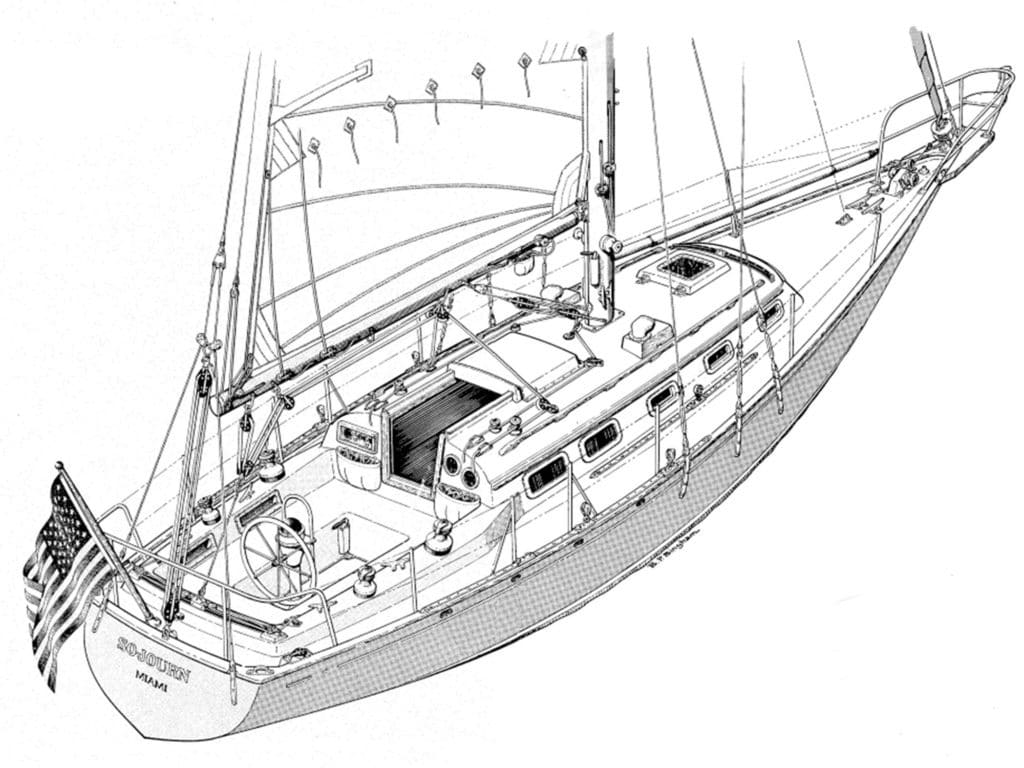
During my 75 years of sailing, I’ve become aware of the chasm between cruisers and racers. But I’ve never understood it because I have always been both. Even when I cruise, I’m racing—against changing weather, the need to get home in time for dinner, whatever. What that really means is that I’m determined to get the most speed out of my boat at all times. And to do so means having excellent running-rigging systems.
There are three issues in play when deciding on whether to install or upgrade your running rigging. First, do you want to increase your ease and convenience when adjusting sail trim? Second, are you willing to add lengths of line (as well as lengths of time) to make sail-trim adjustments? And last, how much investment are you willing to make to reach your sail-handling (i.e., running-rigging) goals?
I can scratch only the surface of this complicated topic and not present a comprehensive guide to all systems and conditions. Hopefully I’ll encourage you to think of how you might be able to improve your systems to make your sailing better and more satisfying.
Let’s begin by looking at sail-trim adjustments, which encompasses many items: sail curve (or draft, also called cord), luff tension, foot tension, sail twist from head to foot, and attack angle (the angle of wind as it approaches the sail’s leading edge, or luff).
On racing boats, all of the power required to make these adjustments is enhanced with more-powerful winches, larger crews, expensive low-friction blocks, and extremely strong and flexible lines. All of the running-rigging systems on racing boats are also appropriate for cruising boats, but cost often plays a deciding factor when making hardware and arrangement choices.
Increasing the power of running-rigging systems will always cost more, but it will also result in ease of handling and efficiency of controlling mainsail and headsail trim. Let’s move on, focusing first on the main.
Main Outhaul
Mainsail draft (depth of the sail’s curve) is controlled primarily by the outhaul but also may be supplemented by halyard tension and mast bend. So, let’s concentrate on the outhaul if for no other reason than its ease of use, as long as it is easily adjustable and also conveniently reachable. Unfortunately, most outhauls that I see on cruising boats are not adjustable and are usually a bundle of knots, difficult to reach when under sail, and almost impossible to untie without a marlinspike or fid. So let’s fix this first.
The mainsail outhaul on my Cape Dory 28 Nikki ’s boom end is a 2-to-1 tackle with its hauling end attached to another 2-to-1 tackle, also called a cascade or Burton. In light air, when sailing to weather, the draft of the main can be flattened by taking in on the 2-to-1 part of the tackle. In strong breezes, flattening the mainsail’s draft is easily done by hauling in on the Burton only, a total power ratio of 4-to-1. Both of the outhaul tackles have their own clam cleats mounted on the side of the boom.
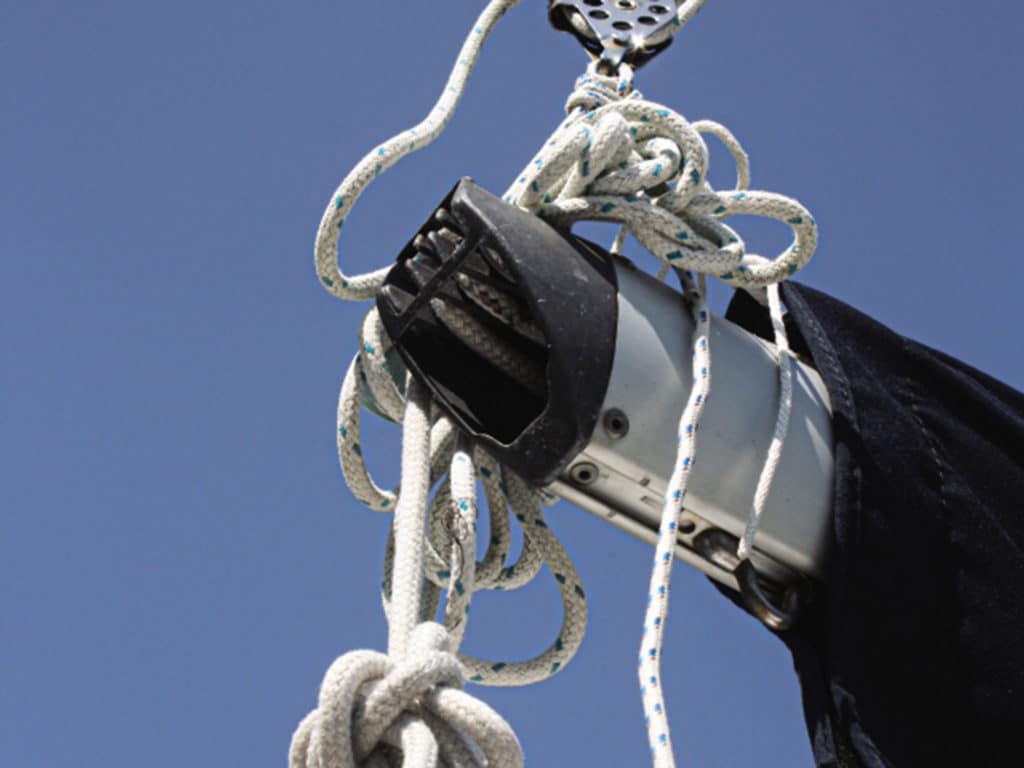
I don’t recommend mast bending to most cruisers because its proper application depends largely on the boat owner’s knowledge of the nature and dimensions of the curve built into the sail by the sailmaker. In a nutshell, though, when sailing to weather, mast bend will flatten the luff of the sail. When sailing off the wind or in light air, a straight mast will increase the curve or draft of the sail for better drive.
If your halyards are only general-purpose Dacron line (like those used for dock lines and sheets), as you tighten them, they will stretch and have little to no effect on sail shape with increased wind. Keep in mind that as windspeed increases, the draft of your sails will also increase, causing a greater heeling moment. The increased draft will also cause the sail luff to become fuller and reduce the ability to point upwind.
I really like limited-stretch and no-stretch halyards. They help reduce the sail draft near the luff from increasing when the wind builds. Limited-stretch halyards won’t stretch markedly when tightened in order to flatten the sail luffs. No-stretch or limited-stretch halyards might sound racy and will cost more, but the payoff is better performance, especially in strong winds. Good halyards are an easy fix that pay big dividends.
Cunninghams and Downhauls
Cunninghams and downhauls are essentially the same thing: Their function is to provide tension adjustment to the lower portion of the luff of a sail. A Cunningham, however, is more associated with the mainsail; downhauls are generally used with a headsail or staysail.
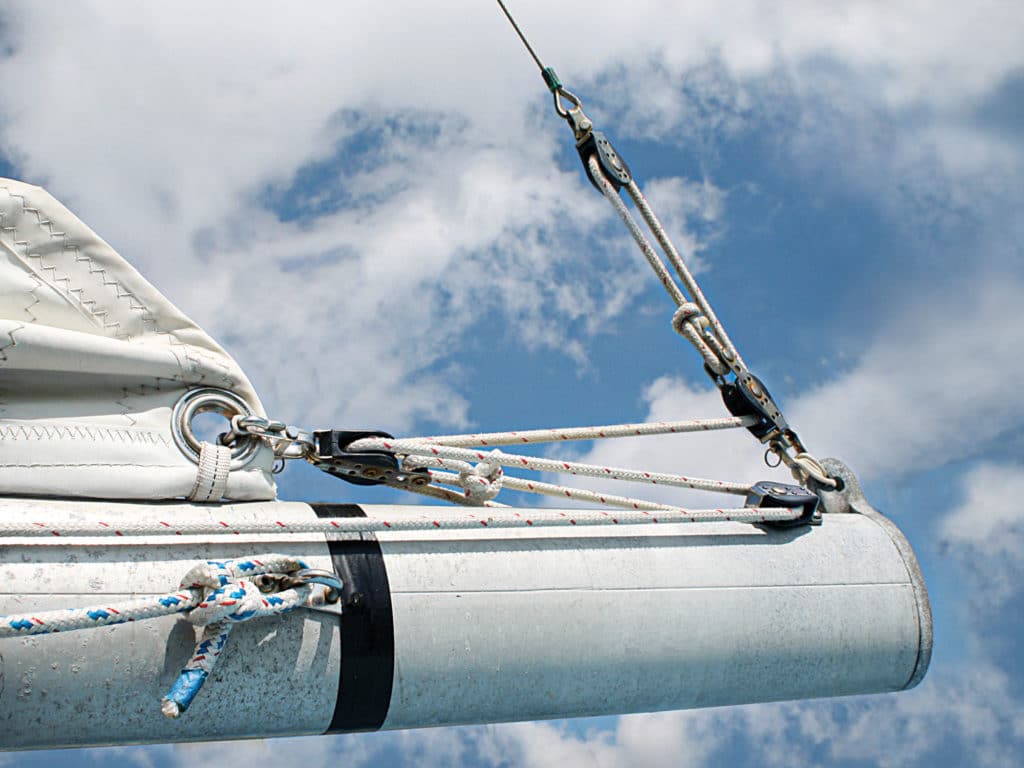
The purpose of Cunninghams and downhauls is to provide a rapid and convenient method of changing and distributing the tightness of a sail luff from tack to head, primarily on sails whose luff is in a mast slot, aluminum furling extrusion or attached to a stay with piston hanks; all of which cause friction that resists the luff from equalizing its load along its length. Since the halyard pulls upward from the top and the Cunningham pulls downward from slightly above the tack, the load in both directions equalizes the tension of the sail’s luff.
When you hoist a mainsail, there will often be about twice the tension on the luff above the spreaders than between the spreaders and the gooseneck. The load on the Cunningham is used to increase the lower luff tension. So, instead of cranking the halyard so tight that the winch is nearly torn off the mast or cabin top, raise the sail only until you begin to feel the luff load up, then tighten up the Cunningham until it feels about the same as the halyard. That’s the way your mainsail was designed and made, with about equal tension along the full length of the luff.
The cordage used as a downhaul or tack attachment for staysails and headsails, including those with roller-furling systems, should be set up as tackles that are adjustable under sail. The cord should be long enough to set up a 4-to-1 tackle, and cleated or tied so that rapid luff tension can be adjusted without a hassle, whether slacking off in light air or tightening in a heavier breeze.
Gaining Mechanical Advantage
When I bought my schooner, At Last , back in the mid-’70s, she had lots of line and blocks but not a single winch. I think that most of her previous sailing had been done by a crew of six or a smaller crew made up of 300-pound gorillas. At that time, I weighed only 135 pounds, and my partner, Katy, was about 15 pounds lighter. Neither of us were what you would call “husky.”
Sailing At Last in light air was not difficult, but when it blew over 8 knots, every evolution became quite physical. We learned the first rule of manpower pretty quickly: The more line we pulled to achieve any sail adjustment (main or foresail sheet trimming, gaff hoisting, etc.), the more power was developed and less personal exertion was required.
Yes, eventually we did install sheet winches for each of the headsail sheets, but not for the main or foresail halyards or sheets, outhauls, vangs or topping lifts. For those, we added blocks and line to each system. It was like multiplying our crew. Every sail-trim maneuver became markedly easier—but slower. So, if we at least doubled the line length by adding sheaves, we also multiplied the power by the same ratio (not deducting for friction) and reduced the hauling load by the same ratio.
The rule of tackles is straightforward: The number of moving parts equals the mechanical advantage (power ratio). Google “block and tackle mechanical advantages,” and you will find excellent graphic diagrams with their power ratios.
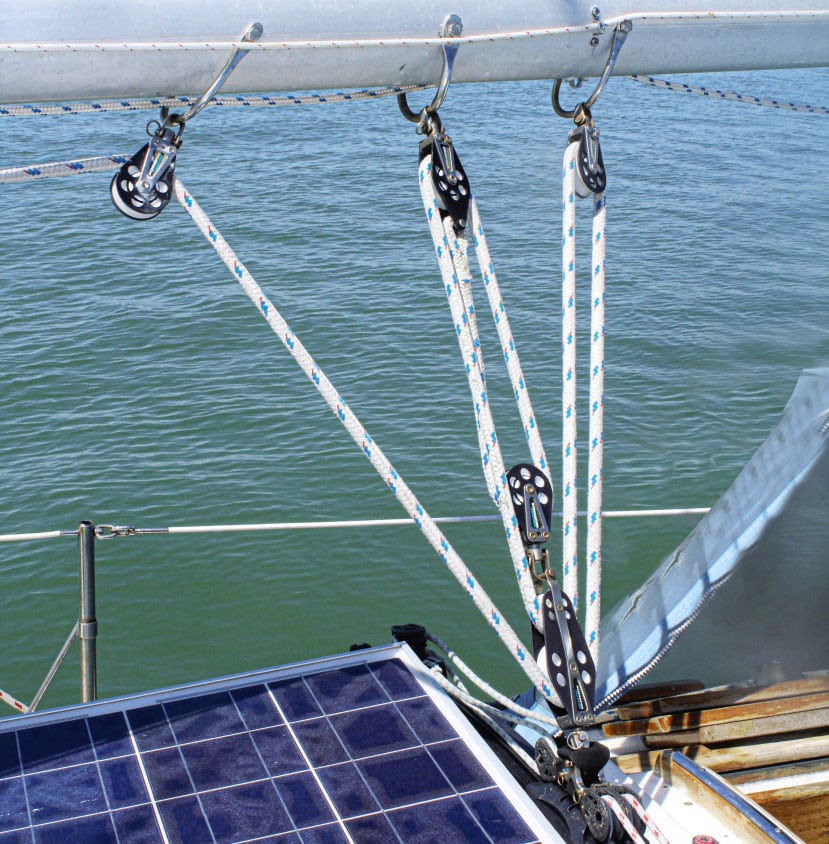
Leading Systems to the Cockpit
More and more boat owners want every sail-control line led to the cockpit. This invariably requires at least three additional blocks or sheaves to be added to most running-rigging systems, thus increasing friction as well as adding lots of line (I call it “spaghetti”) in or near the cockpit. In the case of reefing, leading all lines to the cockpit actually makes most reefing much more difficult and inefficient.
In 2009, my 28-foot Nikki won the Florida West Coast Boat of the Year award in a long series of races over several months’ time. Most wins occurred in extremely high winds because we had practiced reefing in under 45 seconds. That had become possible largely because of deftly efficient tackles, all kept within a single person’s reach. Only the main sheet went to the cockpit and was usually handled by the helmsman.
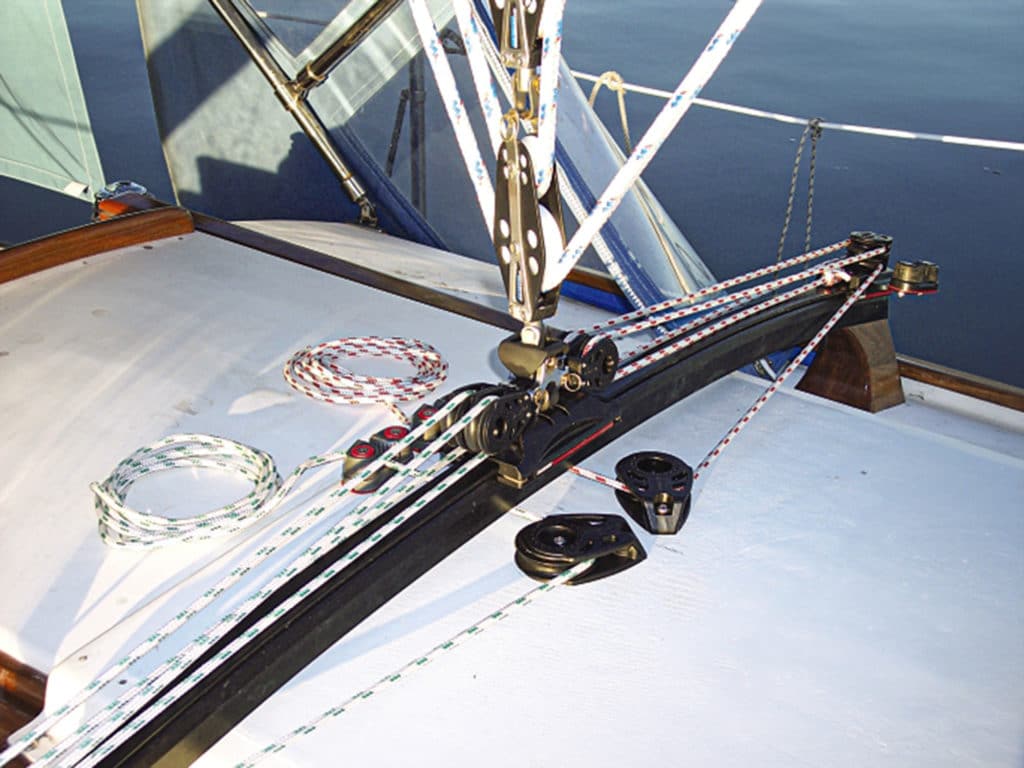
Mainsheets and Travelers
Thirty years ago, virtually all mainsheets were attached to the aft end of the boom and to a multisheave block on a short and mostly inefficient traveler at the stern of the boat. Because of the position of the traveler, its angle of effectiveness was fairly narrow, so when far off the wind (beam and broad reaches and running), the amount of downforce on the boom became little to negligible, rendering the traveler useless.
A double-legged mainsheet never accomplished its intended goal of acting like a traveler. Such a mainsheet always vectors the load to the longitudinal center of the boat on all points of sail regardless how far apart the lower blocks are spread. It was the racers who came up with the idea of moving the mainsheet to the approximate middle of the boom and down to a longer track and adjustable car (the traveler), usually just forward of the main companionway hatch on the cabin top. With this arrangement, the mainsheet becomes the major controller of both boom angle as well as mainsail twist by its increased downforce on the boom and sail.
The traveler car should be controlled by a port and starboard tackle of at least 3-to-1 advantage for boats up to 24 feet, 4-to-1 for boats up to 30 feet, and 5- to 6-to-1 for boats up to 34 feet and beyond. I also recommend the use of cam or clam cleats for all traveler control lines.
Racing sailors also came up with the idea of a boom vang attached to the forward portion of the boom at the upper end, and to a bale at the base of the mast at the lower end. This is what you usually see on most sailboats today. That simple arrangement was a giant leap forward in the area of mainsail-twist control. But almost indiscernible additional improvement seemed to occur. Nowadays, most boom vangs aren’t all that efficient and ought to be brought into this century.
The first improvement should be to pull downward on the boom vang line in order to pull down the boom. However, I rarely see a vang rigged this way, which means it loses about half of its power advantage. Most vangs I see are pulled upward or aft to exert a download on the boom, thus losing more power.
A really practical boom vang should have at least a snap shackle on the lower block so it can be quickly detached from the mast base and moved to a car on the genoa track or a hole in a perforated aluminum toe rail. This will allow the boom vang to exert much more of a vertical download. The more vertical the vang, the more downforce on the boom. Another benefit to the detachable boom vang is that the lower block can be brought forward of the mast and attached to a stout deck-pad eye or perforated toe rail so the boom vang can also act as a preventer when sailing downwind.
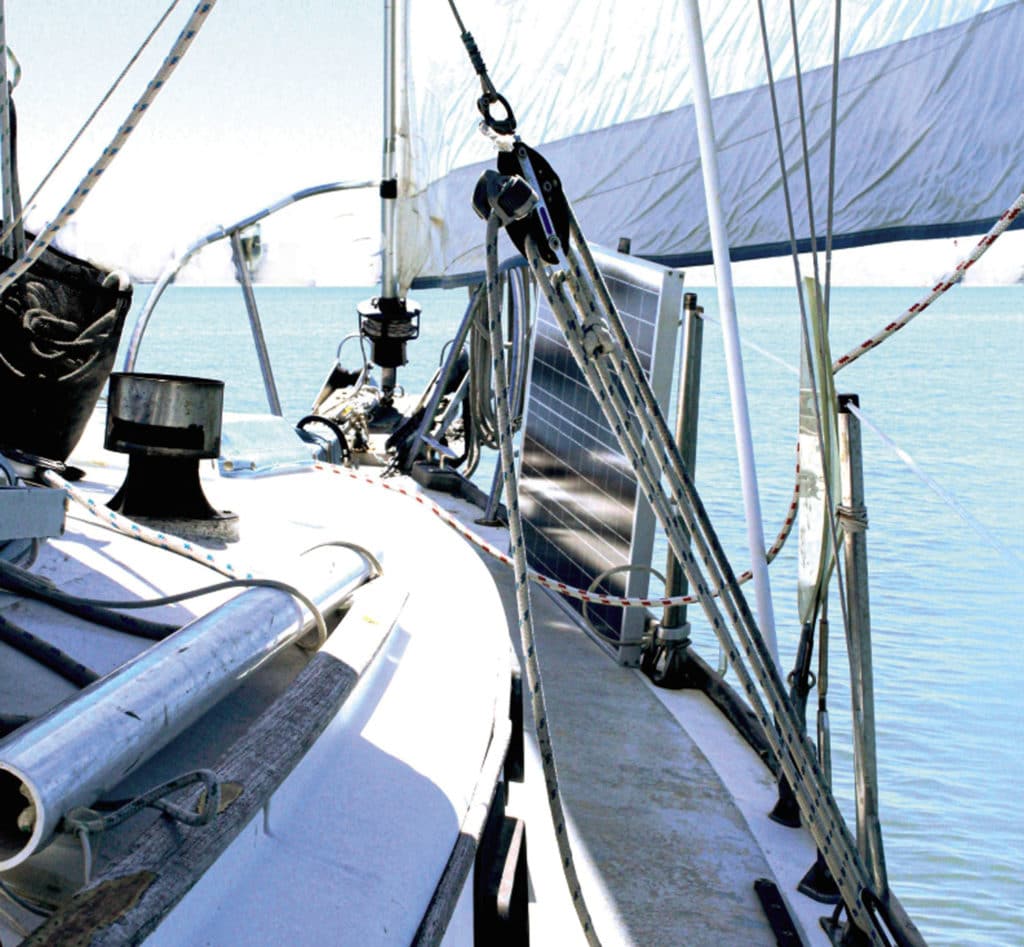
Doubling the power of the boom vang can be accomplished simply and easily with a small investment by adding a 2-by-1 cascade (also, again, called a Burton), which is a single 7-by-7-foot or 7-by-37-foot stainless cable run though a wire block on the boom with one end shackled to the vang bale at the mast base. The other end of the wire is fashioned with an eye to which the upper end of the vang tackle is attached. So if your vang tackle is 5-to-1 and the cascade is 2-to-1, your vang will become 10-to-1. Then by moving the lower end of the vang from the mast to the toe-rail eye, a dedicated deck-pad eye or a genoa-track car, you have doubled it again, all for about $40.
The vang that I have described is most efficient when sailing long distances without jibing or tacking, but if you’re simply afternoon daysailing around the bay, the vang would be more conveniently left attached to the bale at the mast base.
I have never seen a rigid boom vang that was routinely adjusted while under sail; they’re really only a boom support system while under power or tied up to a dock.
Main Boom Topping Lift
I put the topping lift in the same underused category with the main outhaul; too often it’s a bundle of knots at the end of the boom that have not been adjusted or adjustable in decades.
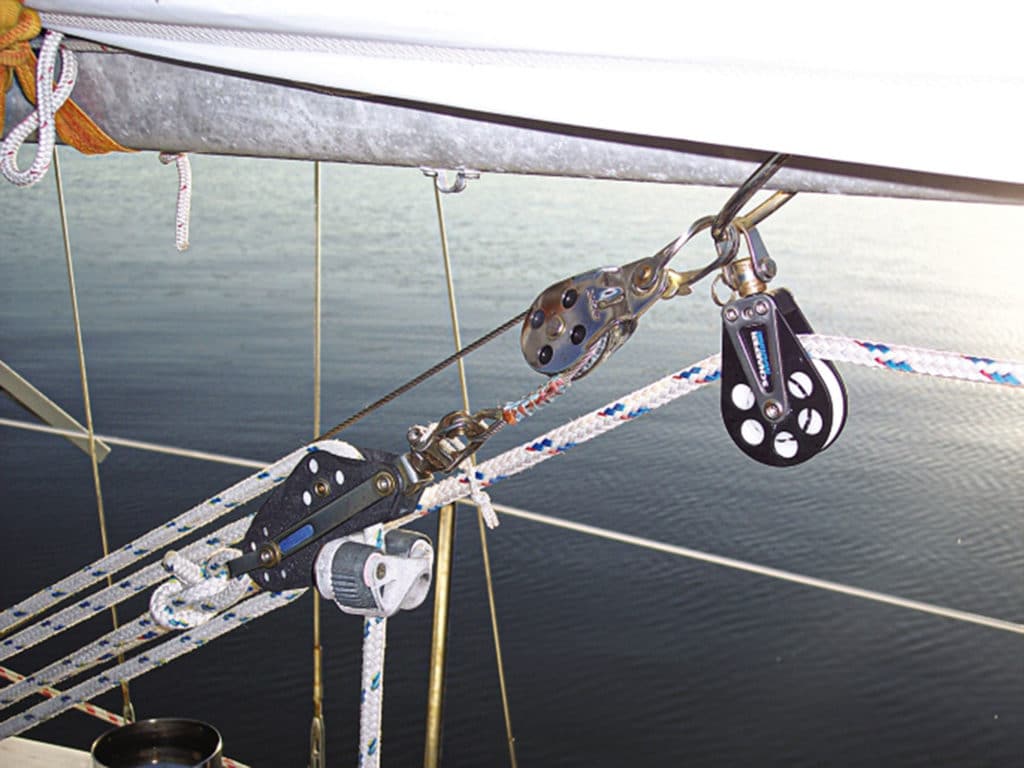
A proper topping lift is meant to raise and store the boom off the Bimini when not in use. When under sail, however, its purpose is to adjust the weight of the boom so it changes the sail twist in various wind conditions and points of sail. It works in the opposite direction of a boom vang; it pulls the boom upward while the vang pulls downward. Upward increases sail twist, and downward reduces it.
A topping lift should also be used to take the weight of the boom off the mains’l leech when putting in a reef, then tightened again while shaking out the reef. The topping lift should be adjustable on any point of sail, which translates into “reachable.” Also, lifting your outboard from your dinghy becomes a simple matter by using your boom vang tackle attached to the end of the boom, and “topping” the boom with the topping lift so the outboard can clear the aft pulpit and lifelines.
Backstay Adjusters
These are used to apply tension to the backstay, which is transferred to the headstay for the purpose of flattening the luff of the headsail…or slacking the backstay, thus also easing the headstay to add more draft to the jib or genoa, as would be desirable when off the wind. When closehauled and/or sailing in a stiff breeze, a flattened headsail is preferred to lessen the boat’s heeling moment and to allow the boat to point up a little closer to the wind. With a backstay adjuster, this can be done in a few seconds with an adequate tackle arrangement.
Adjusting a headstay is usually impossible while under sail with the headsail sheeted in tightly. There are special turnbuckles and hydraulic backstay adjusters that can be used while under sail, but they are not as rapid as the appropriate backstay tackle systems. When tightening the backstay, the mast is also slightly bent to help flatten the draft and remove the “cup” from the luff of the mainsail at the same time as the headsail. So double benefits are derived from one simple adjustment.
Making your boat perform better does not have to be, nor should it be, a lot of work. In reality, effective running-rigging systems will make sailing a lot less strenuous, as well as more enjoyable and rewarding. Your boat will look better and perform better, and teach you a lot about getting the most out of the wind while adding joy to your afternoons under the clouds.
Don’t avoid the possibilities. Embrace them.
Boat designer, builder, writer, illustrator and longtime CW contributor Bruce Bingham lives aboard his Cape Dory 28, Nikki , on Florida’s Gulf coast.
- More: deck hardware , How To , lines , print oct 2020 , rigging
- More How To

DIY Tips for Repairing Nonskid

Shaft Bearing Maintenance Tips

When the Wind Goes Light

How We Built Our Own Bulwarks

Hurricane Beryl Relief Efforts: How You Can Help

Gary Jobson To Talk U.S. Prospects in Upcoming World Sailing Competitions

For Sale: 2005 Tayana 48

Make Downwind Sailing Fun Again. Turn Off That Motor and Unfurl Your Kite!
- Digital Edition
- Customer Service
- Privacy Policy
- Email Newsletters
- Cruising World
- Sailing World
- Salt Water Sportsman
- Sport Fishing
- Wakeboarding
Running Rigging Calculator
Get an instant estimate for your boat, select your boat brand.
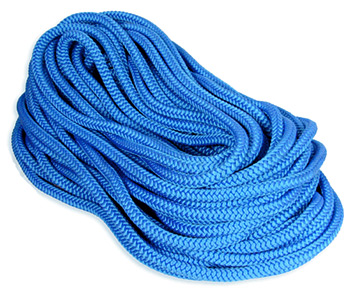
Leaves warehouse: 12 business days
- Copyright 1998-2024 SB Owners, LLC. All rights reserved.

- Policies | Contact Us
Running Rigging
Jib Tack, Jib Halyabds, and Jib Sheets.
The jib tack requires to be of great strength, and is made indifferently, accordingly to the judgment of the person who has the fitting out of the yacht, of rope, chain, or flexible wire rope. Rope does very well in vessels under 40 tons, but wire is to be preferred, and it is found to stand better than chain. The jib tack t is fast to the traveller a (Fig. 15), and leads down through a sheave hole * at the bowsprit end (inside the cranse iron) a block is shackled to the end of the tack through which the outhaul is rove. The standing part of the outhaul is put over one of the bitts with a running eye; the hauling part leads on board by the side of the bowsprit. A single rope inhaul is generally fast to the traveller.
The score in the end of the bowsprit has necessarily to be very large, and frequently it is made wider than it need be; at any rate the sheave hole is a source of weakness, and generally if the end of the bowsprit comes off it is close outside the sheave hole, the enormous lateral strain brought on the part by the weather shroud (%) causing the wood to give way. To avoid such accidents as these one or two yachts have the sheave outside the iron, as shown by to. The tack n passes between the ears or "lugs" on the cranse iron at o and p. To o the topmast stay is fitted, and the bobstay block at p. Of course if the score and sheave were put at m, the other score and sheave * would be dispensed with. Generally when the end comes off at the sheave 8 the bowsprit immediately afterwards breaks close off at the stem, unless some one is very smart at letting the jib sheets fly, or in putting the helm down. With the sheave hole at m no such accident would happen.
Jib halyards are, as a rule, made of chain, as it runs better and does not stretch, and the fall stows in a smaller compass when the jib is set; in fact, the fall is generally run through one of the chain pipes

into the forecastle, where it helps a trifle as ballast.* However, several large vessels, such as Livonia, Modwena, and Arrow, have had Manilla rope. The jib halyards are rove through an iron (single) block (which is hooked or shackled to the head cringle of the jib), and then each part leads through an iron (single) block on either side of the masthead (see Fig. 5). The hauling part usually leads down the port side of the mast; the purchase is shackled to the part that leads through the block on the starboard side. In vessels above 40 tons a flexible wire runner is invariably used in addition to the purchase; one end of the runner is shackled to an eye bolt on deck, and the other, after leading through a block on the end of the jib halyard, is shackled to the npper block of the purchase. The purchase consists of a double and single block, or two double; in the former case the single block is below, with the standing part of the tackle fast to it; but where two blocks are used, the standing part of the tackle is made fast to the upper block. As a great deal of "beef" is required to properly set up a jib, it is usual to have a lead of some kind for the " fall" * of the purchase on deck, such as a snatch block. It is, of course, necessary to have a " straight" luff to a jib, but very frequently the purchase is used a little too freely; the result is that the forestay is slacked, and perhaps a link gives way in the halyards; or the luff rope of the jib is stranded (generally near the head or tack, where it has been opened for the splice), and sometimes the bobstay-fall is burst. (We once saw the latter mishap occur on board the Oimara during the match at Southsea.) These mishaps can be generally averted by "easing" the vessel whilst the jib is being set up, choosing the time whilst she is in stays or before the wind, and watching to see that the forestay is not slackened.
Jib sheets in vessels under 80 tons are usually single, but in vessels larger than 80 tons they are double. In the latter case there are two blocks, which are put on the clew cringle; a sheet is rove through each block, and the two parts through the jib sheet holes in the wash strake of the bulwarks; one part of the sheet is then made fast and the other hauled upon.
Fobs Halyards, Fobe Tacks, and Fobb Shebts.
The fore halyards are usually fitted as follows: The standing part is hooked or shackled to an eye bolt under the yoke on the port side, then through a single block hooked to the head of the sail, and up through another single block hung to an eye bolt under the yoke on the starboard side. The downhaul is bent to the head cringle or to the hook of the
* The "fell" of a tackle is the pert that is taken hold of to haul upon.
block. No purchase is necessary, as the sail is set on a stay; but in yachts above 10 tons the luff of the sail is brought taut by a tackle hooked to the tack; the tack leads through the stem head. The tackle oonsists of a single and double block, or two doubles according to the size of the yacht. In yachts of 40 tons and upwards the tack is usually made of flexible wire rope.
Fore sheets in yachts under 15 tons are usually made up of two single blocks. The standing part is made fast to the upper block (hooked and moused or shackled to the clew of the sail). In larger vessels a double, or single, or two double blocks are used, the hauling part or fall always leading from the upper block. In very large vessels, such as 100-ton cutters or yawls, or 140-ton schooners , "runners" are used in addition to tackles. These are called the standing parts of the sheets: one end is hooked on the tackle by an eye; the other end is passed through a bullseye of lignum vitss on the clew of the sail, and is then belayed to a cavel. The sail is then Bheeted home with the tackle.
Main and Peak Halyards, Main Tack, Main Sheet, and Main
The main or throat halyards are generally rove through a treble block at the masthead, and a double block on the jaws of the gaff. The hauling part of the main halyards leads down the starboard side of the mast, and is belayed to the mast bitts. The main purchase is fast to the standing part, and usually consists of a oouple of double blocks, and the lower one is generally hooked to an eye bolt in the deck on the starboard side. In vessels under 15 tons it is unusual to have a main purchase, and when there is no purchase the upper main halyard block is a double one, and the lower a single. However, racing 10-tonners have a main purchase, and many 5-tonners have one. The principal object in having a main purchase in a small craft is that the mainsail can be set better, as in starting with "all canvas down" the last two or three pulls become very heavy, especially if the hands on the peak have been a little too quick; and a much tauter luff can be got by the purchasfl^than by the main tack tackle. Of course the latter is dispensed with in small vessels where the purchase is used, and the tack made fast by a lacing round the goose-neck of the boom. By doing away with the tack tackle at least 6in. greater length of luff can be had in a 5-tonner, and this may be of some advantage. The sail cannot be triced up, of course, without casting off the main tack lacing; but some yacht sailers oonsider this an advantage, as no doubt sailing a vessel in a strong wind with the main tack triced up very badly stretches the sail, looks very ugly.
The peak halyards in almost all vessels under 140 tons are rove through two single blocks on the gaff and three on the masthead, as shown in Plate I. and Fig. 5. Some vessels above 140 tons have three blocks on the gaff, and in such cases the middle block on the masthead is usually a double one. The standing part of the peak halyards to which the purchase is fast leads through the upper block and down on the port side.
The usual practice in racing vessels is to have a wire leather-covered span (copper wire is best) with an iron-bound bullseye for each block on the gaff to work upon, and this plan no doubt causes a more equal distribution of the strain on the gaff. The binding of the bullseye

has an eye to take the hook of the block. In Fig. 16 a is a portion of the gaff, b is the span; c c are the eyes of the span and thumb cleats on the gaff to prevent the eyes slipping, d is the bullseye with one of the peak halyard blocks hooked to it.
The main tack generally is a gun tackle purchase, but in vessels above 60 tons a double and single or two double blocks are used. In addition, some large cutters have a runner rove through the tack cringle, one end being fast to the goose-neck of the boom, and the other to the tackle. In laced mainsails the tack is secured by a lacing to the goose-neck.
The main boom is usually fitted to the spider hoop round the mast by a universal joint usually termed the main boom goose-neck.
The main sheet should be made of left-handed, slack-laid, six-stranded Manilla rope. The blocks required are a three-fold on the boom, a two-fold on the buffer or hone, as the case may be, and a single block on each quarter for the lead. Yachts of less than 15 tons have a double block on the boom, and single on the buffer.
Many American yachts have a horse in length about one-third the width of the counter for the mainsheet block to travel on. For small vessels, at any rate, this plan is a good one, as the boom can be kept down so much better on a wind, as less sheet will be out than there would be without the horse. A stout ring of indiarubber should be on either end of the horse, to relieve the shock as the boom goes over.
The mainsail outhaul is made np of a horse on the boom, a shackle as traveller, a wire or chain runner outhaul (attached to the shackle, and rove through a sheave hole at the boom end), and a tackle. (See Fig. 17.) In small vessels the latter consists of one block only; in large vessels of two single, or a double and single, or two double blocks.
The old-fashioned plan of outhaul, and one still very much in use, consists of an iron traveller (a large leather-covered ring) on the boom end, a chain or rope through a sheave hole and a tackle. This latter plan is perhaps the stronger of the two; but an objection to it is that the traveller very frequently gets jammed and the reef cleats have to be farther forward than desirable, to allow the traveller to work.

Sometimes, instead of a sheave hole, the sheave for the outhaul is fitted right at the extreme end of the boom, on to which an iron cap is fitted for the purpose.
Topsail Halyards, Sheets, and Tacks.
The topsail halyards in vessels under 10 tons consist of a single rope rove through a sheave hole under the eyes of the topmast rigging.
Yachts of 10 tons and over have a block which hooks to a strop or sling on the yard, or if the topsail be a jib-headed one, to the head cringle. The standing part of the halyard has a running eye, which is put over the topmast, and rests on the eyes of the rigging; the halyard is rove through the block (which has to be hooked to the yard), and through the sheave hole at the topmast head. It is best to have a couple of thumb cleats on the yard where it has to be slung; there is then no danger of the strop slipping, or of the yard being wrongly slung.
When the topsail yard is of great length, as in most yachts of 40 tons and upwards, an upper halyard is provided (called also sometimes a tripping line or trip halyard, becausfe the rope is of use in tripping the yard in hoisting or lowering). This is simply a single rope bent to the upper part of the yard, and rove through a sheave hole in the pole, above the eyes of the topmast rigging. The upper halyards are mainly useful in hoisting and for lowering to get the yard peaked; however, for very long yards, if bent sufficiently near the upper end, they may in a small degree help to keep the peak of the sail from* sagging to leeward, or prevent the yard bending.
The topsail sheet is always a single * Manilla rope, as tarred hemp rope would stain the mainsail in wet weather. It leads through a cheek block on the gaff end, then through a block shackled to an eye bolt under the jaws of the gaff; but in most racing vessels nowadays a pendant or whip is used for this block, as shown in Plate I. The pendant should go round the mast with a running eye. By this arrangement the strain is taken off the jaws of the gaff and consequently off the main halyards. A common plan of fitting this block and whip is shown in Pig. 18. The hauling part of the sheet is generally put round one of the winches on the mast to " sheet home " the topsail.
The topsail tack is usually a strong piece of Manilla with a thimble spliced in it, to which the tack tackle is hooked.
Jib-topsail halyards and main-topmast-staysail halyards are usually single ropes rove through a tail block on topmast head; but one or two large vessels have a lower block, with a spring hook, which is hooked to the head of the sail. In such cases, the standing part of the halyards is fitted on the topmast head with a running eye or bight.

• The Oimara, cutter, had doable topsail sheets rove in this way : one end of the sheet was made fast to the gaff end; the other end of the sheet was rove through a single block on the clew of the sail; then through the oheek block at the end of the gaff, through a block at the jaws of the gaff, and round the winch.
Spinnaerb Halyards, Outhaul, &c.
Spinnaker halyards are invariably single, and rove through a tail block at the topmast bead.
The spinnaker boom is usually fitted with a movable goose-neck at its inner end. The goose-neck consists of a universal joint and round-neck pin, and sockets. (Square iron was formerly used for the neck, but there was always a difficulty in getting the neck shipped in the boom, and round iron was consequently introduced.) The pin is generally put into its socket on the mast, and then the boom end is brought to the neck.
At the outer end of the boom are a couple of good-sized thumb cleats, against which the running eye of the after and fore guy are put. The fore guy (when one is used) is a single rope; the after guy has a pendant or whip with a block at the end, through which a rope is rove. The standing part of this rope is made fast to a cavel-pin on the quarter, and so is the hauling part when belayed. The after guy thus forms a single whip-purchase (see Plate I.). The outhaul is rove through a tail block* at the outer end of the spinnaker boom, and sometimes a snatch block is provided for a lead at the inner end on th§ mast. The topping lift consists of two single, a double and single, or two double blocks, according to the size of the yacht.
The upper block of the topping lift is a rope strop tail block, with a running eye to go round the masthead. The lower block is iron bound, and hooks to an eye strop on the boom.
Formerly a bobstay was used ; but, if the boom is not allowed to lift, it will bend like a bow; in fact, the bobstay was found to be a fruitful cause of a boom breaking, if there was any wind at all, and so bobstays were discarded. The danger of a boom breaking through its buckling up can be greatly lessened by having one hand to attend to the topping lift; as the boom rears and bends haul on the lift, and the bend will practically be "lifted" out.
Small yachts seldom have a fore guy to spinnaker boom, but bend a rope to the tack of the sail (just as the outhaul is bent) leading to the bowsprit end; this rope serves as a fore guy, or brace, to haul the boom forward; and when the spinnaker requires to be shifted to the bowsprit, the boom outhaul is slackened up and the tack hauled out to bowsprit end. Thus double outhauls are bent to the spinnaker tack cringle, and one
• Formerly a hole vu out in the boom end, and a sheaye fitted for the outhaul to run through; this plan is now abandoned, as, unless the boom happens to oome with one partionlar side uppermost, an unfair lead may result rove through the sheave hole or block at the spinnaker boom end, and the other through a block at bowsprit end. But generally the large spinnaker (set as such) has too much hoist for the jib spinnaker, and a shift has to be made for the bowsprit spinnaker, which is hoisted by the jib topsail halyards if that sail be not already set; even in such case no fore guy is used in small vessels, but to ease the boom forward one hand slackens up the topping lift a little, and another the after guy, and, if there be any wind at all, the boom will readily go forward. In a five-tonner the after guy is a single rope without purchase, and the topping lift is also a single rope, rove through a block under the lower cap.
A schooner has a main and fore spinnaker fitted in the manner just described, and the usual bowsprit spinnaker as well, which is usually hoisted by the jib topsail halyards.
As spinnaker booms are now carried so very long, they will not go under the forestay; consequently, when the spinnaker has to be shifted, the boom must be unshipped. To shift the boom, the usual practice is to top it up, lift it away from the goose-neck, and then launch the inner end aft till the outer end will clear the forestay, or leech of foresail if that sail be set. If the boom is not over long, the inner end can be lowered down the fore hatch or over the side of the vessel until the other end will clear the forestay (see als<J page 79).
When spinnakers were first introduced no goose-neck was used, the heel of the boom being lashed against the mast. A practice then sometimes was to have a sheave hole at either end of the boom, with a rope three times the length of the boom rove through each sheave hole. One end of this rope served as the outhaul, the other for the lashing round the mast. To shift over, the boom was launched across to the other rail, and what had been the inboard end became the outboard end. Of course the guys had to be shifted from one end to the other. As spinnaker booms are now of such enormous length, it would be almost impossible, and highly dangerous, to work them in this way, although it might do for a five-tonner.
Spinnaker booms when first fitted with the goose-neck were no longer than the length from deck to hounds, so that they could be worked under the forestay without being unshipped. However, it would appear that the advantages of a longer boom are greater than the inconvenience of having to. unship it for shifting, and now, generally, a spinnaker boom when shifted and topped up and down the mast, reaches above the upper cap.
The following plan was worked during the summer of 1876 in the Lily, 10-tonner, but we have never met with it elsewhere. The arrangement was thus described: Take a yacht of say 65 tons, and suppose her 70ft. long and 15ft. beam, with a mast measuring 60ft. from deck to cap, from which if 9ft. is subtracted for masthead, and 4ft. more allowed for the angle made by the forestay, a spinnaker boom, to swing over clear, cannot exceed 43ft. (as the goose-neck is 3ft. from deck), which of course is much too little to balance the mainboom and sail. It is proposed to have a boom of 42ft., and another smaller one of 21ft. made a little heavier than the long one, and fitted with two irons 7ft. apart; the longer one to be made in the usual manner, with bolts in both ends, for the goose-neck; but the sheaves in the ends to be, one vertical, and the other horizontal. It will then make a very snug storm boom for the balloon jib when shipped singly, whilst the smaller one, by leading a tack rope (or outhaul) through the block on the outer iron will do very well for the staysail. See Fig. 19: in case No. 1, the boom is on end and ready for letting fall to starboard; and in Ho. 2 dipped and falling to port. A A (No. 1) represents the 42ft. boom, and B B the 21-footer; the dotted line b b the arc the boom would travel if not let run down; and the dotted line c c the actual line it travels when housed. C in the small diagram represents the outer iron or cap on the end of the small

boom (which can be made square or round; in the diagram it is made square, to prevent twisting), and a a bolt to which the standing part of the heel rope is made fast by clip hooks; the rope passes through the horizontal sheave at h, and back to the block on the cap at/. The fall can be belayed to a cleat on the small boom, or would greatly ease the strain on the gooseneck if made fast on the rail or to the rigging. When gybing it would only be necessary to top the boom by the lift, let go the heel rope, and let it run down; then swing over, lower away, and haul out the boom when squared. It would be better to hook on the Burton purchase to the cap at e, both as an extra support and to make sure of the boom whilst swinging. This plan would not only obviate the danger and trouble of dipping the boom, but give a 57ft. spar, besides giving greater strength, the boom being double where the most strain comes; and the extra weight is a positive advantage, as helping to balance the main boom. Of course this plan would allow of almost any length of spars, as a 40ft. lower boom would give a 74ft. spar, and still leave 8ft. between the irons; and in these days of excessive spars and canvas no doubt it would be attempted to balance a ringtail, but the lengths given seem a good comparative length for any class.
A more simple plan for " telescoping " a spinnaker boom is shown by
Fig. 20, a is the inner part of the boom; c is a brass cylinder with an
angular slot in it at 8. This cylinder is fixed tightly to the outer part of the boom by the screw bolts i i. The two parts of the boom meet inside the cylinder at the ticked line t. When the two parts "of the boom are to be used together, the ring m is put on the cylinder. The inboard part of the boom is then put into the cylinder, and the whole is firmly screwed up by the thumb-screw x. Both parts of the boom have their ends " socketed " so as to take a goose-neck, and thus either part can be used alone.
Was this article helpful?
Recommended Programs

Myboatplans 518 Boat Plans
Related Posts
- Standing Rigging - Boat Sailing Guide
- Plan Drawing Fregatt - Rigging
- How Are Catamaran Masts Fixed Down
- Rigging a singlehanded dinghy
- Rigging a twohanded dinghy
- Rig Construction - Ship Design
Readers' Questions
What is yacht running rigging?
Yacht running rigging is the ropes and cables used to control the movement of the sails and spars of a sailing yacht. It generally consists of halyards, sheets, guys, and sometimes vangs, used to raise, lower, and angle the sails.
- New Sailboats
- Sailboats 21-30ft
- Sailboats 31-35ft
- Sailboats 36-40ft
- Sailboats Over 40ft
- Sailboats Under 21feet
- used_sailboats
- Apps and Computer Programs
- Communications
- Fishfinders
- Handheld Electronics
- Plotters MFDS Rradar
- Wind, Speed & Depth Instruments
- Anchoring Mooring

Running Rigging
- Sails Canvas
- Standing Rigging
- Diesel Engines
- Off Grid Energy
- Cleaning Waxing
- DIY Projects
- Repair, Tools & Materials
- Spare Parts
- Tools & Gadgets
- Cabin Comfort
- Ventilation
- Footwear Apparel
- Foul Weather Gear
- Mailport & PS Advisor
- Inside Practical Sailor Blog
- Activate My Web Access
- Reset Password
- Customer Service

- Free Newsletter

Maine Cat 41 Used Boat Review

CS 30 Used Boat Review
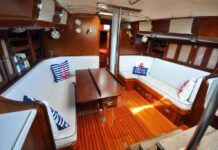
Hinckley 49 Used Boat Review
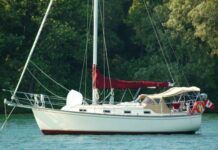
Island Packet 31 Used Boat Review

Best Crimpers and Strippers for Fixing Marine Electrical Connectors

Thinking Through a Solar Power Installation

How Does the Gulf Stream Influence our Weather?

Can You Run a Marine Air-Conditioner on Battery Power?

Master the Sailing Basics: Never Stop Learning the Little Things

How to Mount Your Camera on Deck: Record Your Adventures with…

Un-Stepping the Mast for America’s Great Loop

Headsails and Spinnakers: How to Explain Their Functions to a Beginner

Sinking? Check Your Stuffing Box

The Rain Catcher’s Guide

How to Change Your Engine Mounts

Keeping Water Clean and Fresh

Vinyl Boat Lettering DIY Application and Repair

Those Extras you Don’t Need But Love to Have

Three-Model BBQ Test

Alcohol Stoves— Swan Song or Rebirth?

Womens Foul-Weather Gear

Preparing Yourself for Solo Sailing

How to Select Crew for a Passage or Delivery

Preparing A Boat to Sail Solo

Chafe Protection for Dock Lines

Waxing and Polishing Your Boat

Reducing Engine Room Noise

Tricks and Tips to Forming Do-it-yourself Rigging Terminals

Marine Toilet Maintenance Tips

In Search of the Snag-free Clew
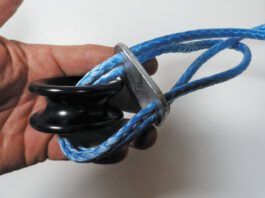
The Cruising Sailor’s Argument for High-tech Fibers
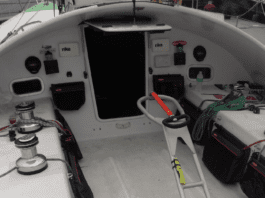
Line Stowage Bags and Hooks
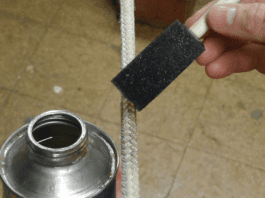
PS Advisor: Rope Coatings to Prolong Cordage Life

Designing a Dump Line for the Multihull Mainsheet
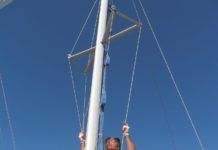
Years Later, Mast Mate Still Riding High
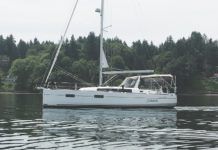
Mailport: anchoring etiquette, stern-tied boats, and wind generators

Overheating Ropes
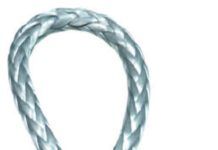
Working with High-Tech Ropes

Adding a Polyester Cover to Dyneema Single Braid

Splice Failure Linked to Fatality

A Sure Way to Secure the Boom
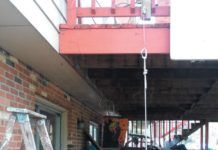
Dyneema Abrasion Test
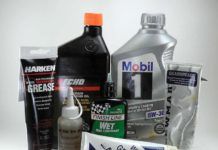
Penny Pincher Pawl Lube
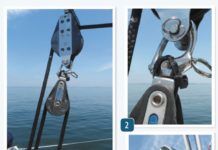
Undoing Mainsheet Twist
Latest videos.

Hunter Legend 35.5 – Behind the Curtain

Whipping Line On Your Sailboat

Hallberg Rassy 42 – Behind the Curtain

The ICW – The Easiest Way – Sail to the Sun...
- Privacy Policy
- Do Not Sell My Personal Information
- Online Account Activation
- Privacy Manager
× You are using an outdated browser. Please upgrade your browser to improve your experience.
We Ship Worldwide! | FREE SHIPPING! for US Continental orders over $99. Click for details.

Shopping Cart
Your cart is currently empty..
FREE SHIPPING! for US Continental orders over $99 click for details
Sailboat Running Rigging

Running Rigging components include all hardware necessary to construct halyards, sheets and control lines for your sailboat like halyard shackles, shackle guards, spool shackles, thimbles and splicing services.
We at MAURIPRO Sailing are fully committed to being your Sailboat Running Rigging specialist not only providing the sailing community with a comprehensive and easy-to-use website, but also with all the appropriate technical information that you might need to select your sailboat hardware and equipment.
MAURIPRO Sailing, your direct access to Sailboat Running Rigging and all your other sailing and boating needs.
Copyright © 2024 MAURIPRO Sailing LLC.

- Lines & Rigging
Sailboat Running Rigging
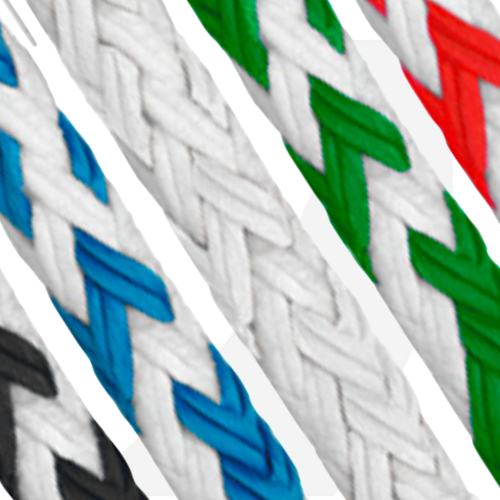
Sea Sure 8mm Heavy Duty S/S Thimble

Sea Sure 6mm Heavy Duty S/S Thimble

Sea Sure 5mm Heavy Duty S/S Thimble

Sea Sure 4mm Heavy Duty S/S Thimble

Sea Sure 3mm Heavy Duty S/S Thimble
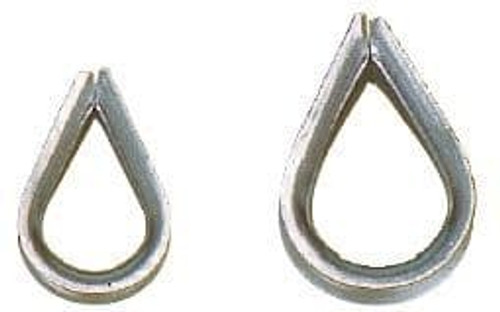
Sea Sure 2mm Heavy Duty S/S Thimble

Sea Sure 5mm Wire Rope Grip (1830-5mm)
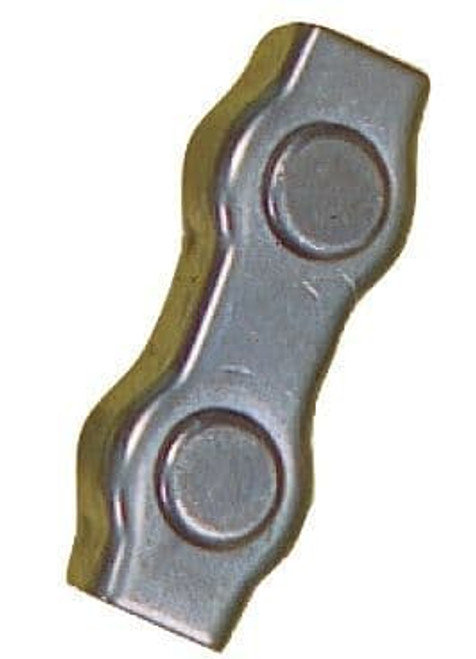
Sea Sure 4mm Wire Rope Grip (1830-4mm)
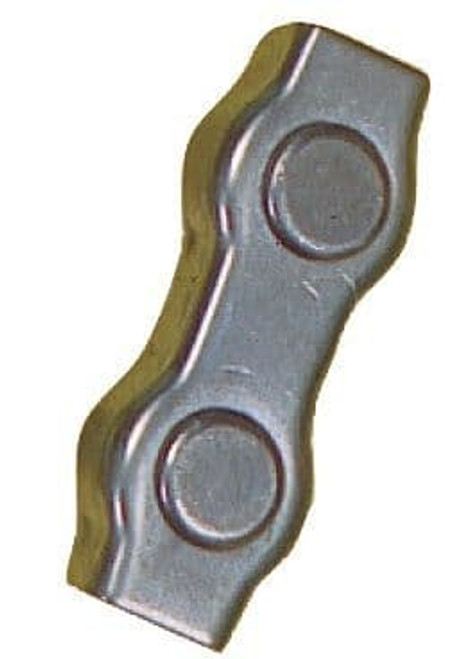
Sea Sure 3mm Wire Rope Grip (1830-3mm)

Sea Sure 6mm Light Duty S/S Thimble (SP67E)
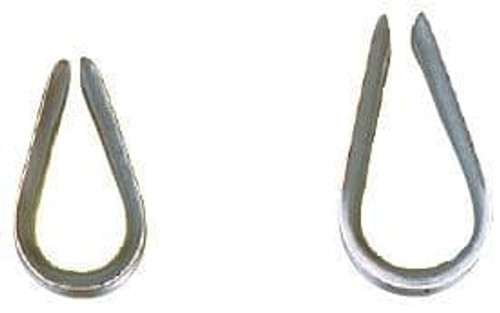
Sea Sure 5mm Light Duty S/S Thimble (SP67D)

Sea Sure 4mm Light Duty S/S Thimble (SP67C)

Sea Sure 3mm Light Duty S/S Thimble (SP67B)

Sea Sure 2mm Light Duty S/S Thimble (SP67A)
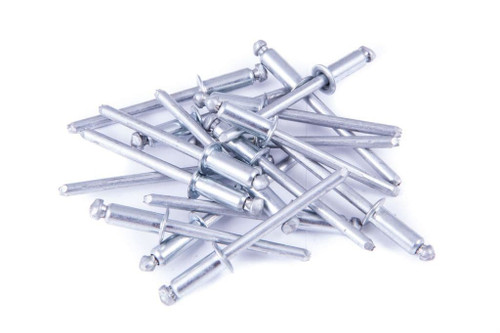
Sea Sure 1/4"x3/4" Monel Pop Rivet - TLP/D/870BS

Sea Sure 1/4"x1/2" Monel Pop Rivet - TLP/D/850BS

Sea Sure 3/16"x5/8" Monel Pop Rivet - TLP/D/665

Sea Sure 3/16"x3/4" Monel Pop Rivet - TLP/D/675BS

Sea Sure 3/16"x1/2" Monel Pop Rivet - TLP/D/650BS

Sea Sure 3/16"x3/8" Monel Pop Rivet - TLP/D/639BS
JIB FURLING GEAR
- CDI Flexible
- Furling Accessories
- Racing Foils
- Whisker and Spinnaker
MAIN SAIL FURLING and REEFING
- Boom Furlers
- Reefing and LazyJacks
MAIN SAIL TRACK SYSTEMS
Standing rigging.
- Swage Terminals and Toggles
- Turnbuckles
- Backstay Adjusters
- Inner Forestay Tools...
- Miscellaneous Hardware
- Measuring Guide
- Hardware and Wire
RUNNING RIGGING
- Rope Clutches
- Cam and Standard Cleats
- Pad Eyes, Eye Straps
- Rachet, Snatch, Wire
- Halyard Lift
- Accessories
- rigid vangs
- tackle vangs
GROUND TACKLE
Mast climbing.
- ATN Top Climber
RADAR MOUNTS AND REFLECTORS
Welcome to rigging only.
Our www.riggingandhardware.com shop on line site is now open for business. We now have most manufacture's parts up and running. Pricing is current on the riggingandhardware.com site. Pictures and selection guides are rather lacking at this time but we are working on them and will be loading more product and manufacturers asap. As always, don't hesitate to contact us with any questions or to place an order at [email protected] or call (508) 992-0434.

Our Mission
- We now stock and swage wire up to 5/8 diameter for sailboat standing rigging and architectural wire projects. Larger sizes are available.
- We now stock and swage wire up to 5/8 diameter for standing rigging and architectural projects. Larger sizes are available.
- Metric wire and swage fittings are available for standing rigging applications. We are able to provide swaged standing rigging assemblies as well as mechanical terminals (assembled or you assemble) to meet your needs at an affordable cost. Current stock is 8-10-12mm. Note the bulk of these fittings will have imperial pin and thread dimensions.
Return Policy
Customer comments.
- We thank you and your staff for your help and advise. We are enjoying sailing more with the furler. M.&R. G., Chicago
- All arrived safely and perfectly on time. The lifelines are almost too pretty to put on the boat and it's a damn pretty boat. The shrouds and backstay are superb and a perfect fit. If anyone ever wants a referral about Rigging Only tell them to contact me. R. A. , Curator, N. C.
- Just a quick note to tell you how grateful I am. The order was waiting for me when I arrived as promised. All the parts were of top quality and the prices were more than reasonable. I am recommending the services and products of Rigging Only to all my fellow charter captains of the Virgin Islands Charter League. Capt. G. F. USVI
- Due to your excellent quality, service, and prices on my previous order I would like to get a price quote and estimated turnaround time for replacing my current standing rigging... B. S. Gurnee, IL.
- Got them on time! Many Thanks! C. S. Lacombe, LA
Contact Information
No products in the cart.
Sailing Ellidah is supported by our readers. Buying through our links may earn us an affiliate commission at no extra cost to you.
The Standing Rigging On A Sailboat Explained
The standing rigging on a sailboat is a system of stainless steel wires that holds the mast upright and supports the spars.
In this guide, I’ll explain the basics of a sailboat’s hardware and rigging, how it works, and why it is a fundamental and vital part of the vessel. We’ll look at the different parts of the rig, where they are located, and their function.
We will also peek at a couple of different types of rigs and their variations to determine their differences. In the end, I will explain some additional terms and answer some practical questions I often get asked.
But first off, it is essential to understand what standing rigging is and its purpose on a sailboat.
The purpose of the standing rigging
Like I said in the beginning, the standing rigging on a sailboat is a system of stainless steel wires that holds the mast upright and supports the spars. When sailing, the rig helps transfer wind forces from the sails to the boat’s structure. This is critical for maintaining the stability and performance of the vessel.
The rig can also consist of other materials, such as synthetic lines or steel rods, yet its purpose is the same. But more on that later.
Since the rig supports the mast, you’ll need to ensure that it is always in appropriate condition before taking your boat out to sea. Let me give you an example from a recent experience.
Dismasting horrors
I had a company inspect the entire rig on my sailboat while preparing for an Atlantic crossing. The rigger didn’t find any issues, but I decided to replace the rig anyway because of its unknown age. I wanted to do the job myself so I could learn how it is done correctly.
Not long after, we left Gibraltar and sailed through rough weather for eight days before arriving in Las Palmas. We were safe and sound and didn’t experience any issues. Unfortunately, several other boats arriving before us had suffered rig failures. They lost their masts and sails—a sorrowful sight but also a reminder of how vital the rigging is on a sailboat.
The most common types of rigging on a sailboat
The most commonly used rig type on modern sailing boats is the fore-and-aft Bermuda Sloop rig with one mast and just one headsail. Closely follows the Cutter rig and the Ketch rig. They all have a relatively simple rigging layout. Still, there are several variations and differences in how they are set up.
A sloop has a single mast, and the Ketch has one main mast and an additional shorter mizzen mast further aft. A Cutter rig is similar to the Bermuda Sloop with an additional cutter forestay, allowing it to fly two overlapping headsails.
You can learn more about the differences and the different types of sails they use in this guide. For now, we’ll focus on the Bermuda rig.
The difference between standing rigging and running rigging
Sometimes things can get confusing as some of our nautical terms are used for multiple items depending on the context. Let me clarify just briefly:
The rig or rigging on a sailboat is a common term for two parts:
- The standing rigging consists of wires supporting the mast on a sailboat and reinforcing the spars from the force of the sails when sailing.
- The running rigging consists of the halyards, sheets, and lines we use to hoist, lower, operate, and control the sails on a sailboat.
Check out my guide on running rigging here !
The difference between a fractional and a masthead rig
A Bermuda rig is split into two groups. The Masthead rig and the Fractional rig.
The Masthead rig has a forestay running from the bow to the top of the mast, and the spreaders point 90 degrees to the sides. A boat with a masthead rig typically carries a bigger overlapping headsail ( Genoa) and a smaller mainsail. Very typical on the Sloop, Ketch, and Cutter rigs.
A Fractional rig has forestays running from the bow to 1/4 – 1/8 from the top of the mast, and the spreaders are swept backward. A boat with a fractional rig also has the mast farther forward than a masthead rig, a bigger mainsail, and a smaller headsail, usually a Jib. Very typical on more performance-oriented sailboats.
There are exceptions in regards to the type of headsail, though. Many performance cruisers use a Genoa instead of a Jib , making the difference smaller.
Some people also fit an inner forestay, or a babystay, to allow flying a smaller staysail.
Explaining the parts and hardware of the standing rigging
The rigging on a sailing vessel relies on stays and shrouds in addition to many hardware parts to secure the mast properly. And we also have nautical terms for each of them. Since a system relies on every aspect of it to be in equally good condition, we want to familiarize ourselves with each part and understand its function.
Forestay and Backstay
The forestay is a wire that runs from the bow to the top of the mast. Some boats, like the Cutter rig, can have several additional inner forestays in different configurations.
The backstay is the wire that runs from the back of the boat to the top of the mast. Backstays have a tensioner, often hydraulic, to increase the tension when sailing upwind. Some rigs, like the Cutter, have running backstays and sometimes checkstays or runners, to support the rig.
The primary purpose of the forestay and backstay is to prevent the mast from moving fore and aft. The tensioner on the backstay also allows us to trim and tune the rig to get a better shape of the sails.
The shrouds are the wires or lines used on modern sailboats and yachts to support the mast from sideways motion.
There are usually four shrouds on each side of the vessel. They are connected to the side of the mast and run down to turnbuckles attached through toggles to the chainplates bolted on the deck.
- Cap shrouds run from the top of the mast to the deck, passing through the tips of the upper spreaders.
- Intermediate shrouds run from the lower part of the mast to the deck, passing through the lower set of spreaders.
- Lower shrouds are connected to the mast under the first spreader and run down to the deck – one fore and one aft on each side of the boat.
This configuration is called continuous rigging. We won’t go into the discontinuous rigging used on bigger boats in this guide, but if you are interested, you can read more about it here .
Shroud materials
Shrouds are usually made of 1 x 19 stainless steel wire. These wires are strong and relatively easy to install but are prone to stretch and corrosion to a certain degree. Another option is using stainless steel rods.
Rod rigging
Rod rigging has a stretch coefficient lower than wire but is more expensive and can be intricate to install. Alternatively, synthetic rigging is becoming more popular as it weighs less than wire and rods.
Synthetic rigging
Fibers like Dyneema and other aramids are lightweight and provide ultra-high tensile strength. However, they are expensive and much more vulnerable to chafing and UV damage than other options. In my opinion, they are best suited for racing and regatta-oriented sailboats.
Wire rigging
I recommend sticking to the classic 316-graded stainless steel wire rigging for cruising sailboats. It is also the most reasonable of the options. If you find yourself in trouble far from home, you are more likely to find replacement wire than another complex rigging type.
Relevant terms on sailboat rigging and hardware
The spreaders are the fins or wings that space the shrouds away from the mast. Most sailboats have at least one set, but some also have two or three. Once a vessel has more than three pairs of spreaders, we are probably talking about a big sailing yacht.
A turnbuckle is the fitting that connects the shrouds to the toggle and chainplate on the deck. These are adjustable, allowing you to tension the rig.
A chainplate is a metal plate bolted to a strong point on the deck or side of the hull. It is usually reinforced with a backing plate underneath to withstand the tension from the shrouds.
The term mast head should be distinct from the term masthead rigging. Out of context, the mast head is the top of the mast.
A toggle is a hardware fitting to connect the turnbuckles on the shrouds and the chainplate.
How tight should the standing rigging be?
It is essential to periodically check the tension of the standing rigging and make adjustments to ensure it is appropriately set. If the rig is too loose, it allows the mast to sway excessively, making the boat perform poorly.
You also risk applying a snatch load during a tack or a gybe which can damage the rig. On the other hand, if the standing rigging is too tight, it can strain the rig and the hull and lead to structural failure.
The standing rigging should be tightened enough to prevent the mast from bending sideways under any point of sail. If you can move the mast by pulling the cap shrouds by hand, the rigging is too loose and should be tensioned. Once the cap shrouds are tightened, follow up with the intermediates and finish with the lower shrouds. It is critical to tension the rig evenly on both sides.
The next you want to do is to take the boat out for a trip. Ensure that the mast isn’t bending over to the leeward side when you are sailing. A little movement in the leeward shrouds is normal, but they shouldn’t swing around. If the mast bends to the leeward side under load, the windward shrouds need to be tightened. Check the shrouds while sailing on both starboard and port tack.
Once the mast is in a column at any point of sail, your rigging should be tight and ready for action.
If you feel uncomfortable adjusting your rig, get a professional rigger to inspect and reset it.
How often should the standing rigging be replaced on a sailboat?
I asked the rigger who produced my new rig for Ellidah about how long I could expect my new rig to last, and he replied with the following:
The standing rigging should be replaced after 10 – 15 years, depending on how hard and often the boat has sailed. If it is well maintained and the vessel has sailed conservatively, it will probably last more than 20 years. However, corrosion or cracked strands indicate that the rig or parts are due for replacement regardless of age.
If you plan on doing extended offshore sailing and don’t know the age of your rig, I recommend replacing it even if it looks fine. This can be done without removing the mast from the boat while it is still in the water.
How much does it cost to replace the standing rigging?
The cost of replacing the standing rigging will vary greatly depending on the size of your boat and the location you get the job done. For my 41 feet sloop, I did most of the installation myself and paid approximately $4700 for the entire rig replacement.
Can Dyneema be used for standing rigging?
Dyneema is a durable synthetic fiber that can be used for standing rigging. Its low weight, and high tensile strength makes it especially popular amongst racers. Many cruisers also carry Dyneema onboard as spare parts for failing rigging.
How long does dyneema standing rigging last?
Dyneema rigging can outlast wire rigging if it doesn’t chafe on anything sharp. There are reports of Dyneema rigging lasting as long as 15 years, but manufacturers like Colligo claim their PVC shrink-wrapped lines should last 8 to 10 years. You can read more here .
Final words
Congratulations! By now, you should have a much better understanding of standing rigging on a sailboat. We’ve covered its purpose and its importance for performance and safety. While many types of rigs and variations exist, the hardware and concepts are often similar. Now it’s time to put your newfound knowledge into practice and set sail!
Or, if you’re not ready just yet, I recommend heading over to my following guide to learn more about running rigging on a sailboat.
Sharing is caring!
Skipper, Electrician and ROV Pilot
Robin is the founder and owner of Sailing Ellidah and has been living on his sailboat since 2019. He is currently on a journey to sail around the world and is passionate about writing his story and helpful content to inspire others who share his interest in sailing.
Very well written. Common sense layout with just enough photos and sketches. I enjoyed reading this article.
Thank you for the kind words.
Leave a Reply Cancel reply
Your email address will not be published. Required fields are marked *

Chicago to Mackinac sailboat race: Storm snaps masts, tosses sailor into Lake Michigan
A fast-moving summer storm Saturday night on Lake Michigan left carnage in its path after three huge sailboats snapped masts and a fourth boat had to rescue a man after he fell overboard, all in the middle of the night under total darkness during the first day of the Chicago to Mackinac race .
“It was about 11:30 Eastern Time and we outpaced a couple storms. The team was getting ready … when a squall hit us. The wind picked up from about 18 knots to over 30 knots and shifted 80 degrees,” Skip Dieball, 53, of Wilmette, Illinois, a tactician racing on the 52-foot Usual Suspects, said on Sunday. “Sometimes in the daytime, you can see some of the shifts coming, the wind pattern on the water. But it was so dark we couldn’t see anything. We told each other we would prepare early. We were, and it just came really fast.”
Disaster was averted after Madcap, a Santa Cruz 52 owned and skippered by John Hoskins, responded to a man overboard report from Callisto, a J/125 owned and skippered by Jim Murray. Both boats resumed racing the 333-statute-mile (289-nautical-mile) race without injury.
Start the day smarter. Get all the news you need in your inbox each morning.
In addition to Usual Suspects, owned by Eric Wynsma, masts broke on the 65-foot Sagamore owned by Laura and Tone Martin, along with the 45-foot Sapphire, owned by Robert Radway. No injuries were reported, according to Laura Muma, communications director for the Chicago to Mackinac race.
Despite being on high alert to take down sails, the demasting events were intense.
‘Loud as the loudest thunder’
As soon as the mast snapped, Dieball said the crew started doing a head count to be certain all 13 sailors were still onboard. The rig could have come down on the crew if they had been in their normal stations, but they were scattered. While the mast “broke violently,” Dieball said, “it did not come down violently.”
The race boat, with its custom carbon fiber mast, strong and light but brittle, is designed for high-performance racing and often used in America’s Cup races.
When the mast broke, it sounded like a “crack of thunder” immediately overhead, Dieball said. “It’s as loud as the loudest thunder.”
When the mast settled, the crew had to rapidly assess next steps. The biggest fear is that the broken mast will bang against the boat and puncture a hole, Dieball said. A mast on a boat that size can be 60 or 70 feet tall, he said.
“Part of your safety equipment is having cutting devices that get the mast away from the boat. The mast had broken in three different spots and it was time to start cutting things away,” Dieball said. “Carbon fiber, in many ways, is sharper than steel. We had to make sure no one was in a spot where one of the pieces would actually cut them.”
So sailors took out cutting tools and knives they’re required to carry as part of the racing protocol — and sliced away rigging as fast as possible, letting material sink into the water.
‘Survival mode’
Skipper Eric Wynsma, a real estate developer from Grand Rapids, had three of his grown kids racing, too. This was his 25th Chicago to Mackinac race.
“We were just in survival mode,” Dieball said, cutting away for about 30 minutes. “After the (storm) cell went through, the wind died off. So it wasn’t like we were battling elements. We were into the race about nine hours, finishing about a third of the course, and we returned to Muskegon.”
After stabilizing the situation, the Usual Suspects crew contacted the U.S. Coast Guard and reported debris in the water. The race boat didn’t need assistance once the rigging was cut away, Dieball said. They made certain nothing was wrapped around the propeller and Usual Suspects spent the next three hours motoring back, arriving about 5 a.m.
No one was freaking out, Dieball said. “It was all business.”
The costly damage prevents Usual Suspects from racing the Bayview Mackinac race from Port Huron to Mackinac, which starts Saturday.
Fast Tango fights DeTour
Tim Prophit , of St. Clair Shores, owner and skipper of the 40-foot Fast Tango, didn’t get slammed by the storm, but his nine-member crew prepared by making sail changes and reefing the main sail for better control.
“All of a sudden, the waves felt different, a different pattern, a different height. And the temps dropped,” he said Sunday while racing. “We were paying very close attention to the weather.”
Fast Tango won its class and placed second overall in the Chicago to Mackinac race last year, and was the overall winner in the Port Huron to Mackinac race.
This year, Fast Tango is battling the 34-foot DeTour, owned by Chuck Stormes, of Grosse Pointe Farms, no stranger to winning class and overall trophies.
Christy Storms said early Sunday afternoon she couldn’t look at the tracker to see how her husband was doing. It made her crazy. She didn’t know there had been a storm, she said, thank God, or she would have been worried sick.
“This is the first year I’ve been trying to not stalk him,” she said. “It’s tough looking every minute. It just makes me crazy.”
Family members are known to sleep with their phones under their pillows, call and text each other every hour through the night until the race is finished.In years past, Christy Storms said, “it was like crack. It just make me so anxious.”
So, she went online, noticed he was doing great, took a snapshot of the tracker, put her phone down and went to bed with their 11-year-old dog Striker.
Early Monday, Prophit confirmed that Fast Tango won first in class against 11 competitors. They crossed the finish line in 41 hours, 59 minutes, 47 seconds.
Chaos on other boats, too
Following the storm, 15- to 20-knot southerly winds continued to propel the 247-boat fleet north, Muma said in the race update.
While mast loss made headlines with sailing reporters, other boats had serious issues that went unreported. And they kept going, hoping for the best.
Mark DenUyl, of Marysville, Michigan, owner and skipper of the 34.5-foot Good Lookin’, watched his carbon fiber bowsprit snap in half during the high winds right about 11:30 p.m. Saturday. Now it’s held together with electrical tape and sail tape.
Crew member Brennan Churchill, 22, texted his dad at home in Kimball, Michigan, with an update on the damaged equipment used to extend the sail, so it captures more wind.
“He knew better than to tell his mother,” Tracy Heany Churchill said Sunday. “He knows I go into freakout mode.”
Ron Churchill always sails with his son, who won his first Mackinac race at age 15, but Ron couldn’t leave work as a senior operations manager for a natural gas storage facility to do both the Chicago and Port Huron races to Mackinac.
“I feel like I’m lost right now. I just feel like I’m supposed to be there,” Ron Churchill said Sunday.
Brennan Churchill described the boat tipping so far to one side that the crew was in waist-deep water, his father said. “Everybody stayed on the boat. Water was washing over them.”
The sudden gust of wind created such force that it likely flexed and snapped, he said. As a result of the damage, the crew held steady until daylight to try and figure out what to do, Churchill said. “They did a good job with just staying composed and keeping the boat moving well.”
On Monday morning, Good Lookin’ crossed the finish line in third in class against a dozen other J/105 boats despite damage to critical equipment.
Cara DenUyl and her 19-year-old daughter, Riley, woke up at 5:30 a.m. Monday to watch online the Good Lookin’ finish. “It was a nail-biter. It was close between second and third. They were in second place at 2 a.m. Sunday, when that storm hit. Then they fell back all the way to seventh place. At the time, we didn’t know the storm had hit. Somehow they got everything fixed enough to keep going, thankfully. I feel relief that they made the podium.”
‘Breathtaking’ speed
With storms come great wind. Or, in sailor speak, great air.
Winn Soldani, race chair of the Chicago to Mackinac race, said this weekend’s storms brought “epic” conditions that weather models predicted, which is important for safety.
“We’re watching boats going 20 knots, or about 23 mph, and it’s breathtaking,” Soldani told Shifting Gears from the finish line near the Mission Point hotel on Mackinac Island on Sunday.
“When the squalls hit, the wind changed direction very rapidly, from out of the south to out of the west, at 33 to 35 mph,” he said. “Some of these sails are the size of tennis courts. They’re huge. So this changes pressure on the mast.”
That’s what causes masts to snap, Soldani said. Strict safety protocols protect the 2,200 sailors racing this year, and that’s why they’re required to wear special tracking devices on their bodies at all times.
Storm winds create record-setting conditions
As a result of the strong winds, this race broke the speed record.
The 80-foot Maverick finished in 22 hours, 24 minutes, 23 seconds, breaking a record set 22 years ago by 66 minutes, 11 seconds.
Sanford Burris, of Kirtland, Ohio, sailed with his sons and friends on the carbon fiber Andrews 80 they have spent the past three years upgrading, according to Muma. The 20-person crew included Rodney Keenan, founder of Evolution Sails.
“The team celebrated briefly as the Maverick team crossed the race to Mackinac finish line between Mackinac Island and the Round Island lighthouse … and then kept on sailing,” said the Chicago to Mackinac news release.
Maverick is one of 25 sailboats registered for this year’s “Super Mac” race, a combination of the Chicago Mackinac and the Bayview Mackinac races, which means they will continue into Lake Huron, heading south to Port Huron, for a total of 565 statute miles (495 nautical miles).
More: Star Line Mackinac Island Ferry Co. sells to Florida billionaire
Phoebe Wall Howard, a Free Press auto reporter for nearly seven years, now writes a column on car culture, consumer trends and life that will appear periodically on Freep.com and in print. Those columns and others will appear on her Substack at https://phoebewallhoward.substack.com/about Contact her at [email protected].
This article originally appeared on Detroit Free Press: Chicago to Mackinac sailboat race: Storm snaps masts, tosses sailor into Lake Michigan


IMAGES
VIDEO
COMMENTS
The running rigging on a sailboat consists of all the lines used to hoist, lower, and control the sails and sailing equipment. These lines usually have different colors and patterns to easily identify their function and location on the vessel. Looking at the spaghetti of lines with different colors and patterns might get your head spinning.
Standing rigging keeps the mast in place, but it's the running rigging that handles all the action aboard a boat under sail. The many components in a modern running rigging system—sheets, outhauls, vang control, halyards—work in conjunction with wide range of blocks to keep friction to a minimum. Ralph Naranjo.
Our sailboat rigging include mainsail halyards, spinnaker halyards, and Genoa halyards that are made from a double braid polyester line, double braid Dyneema line or Vectran. Our mainsheets are also made from durable double braid polyester and hybrid fibers with blend of Dyneema and Technora. This material has the best reputation in the industry.
PLEASE NOTE: THIS VIDEO HAS BEEN UPDATED WITH ENHANCED GRAPHICS AND IMPROVED SOUND. CHECK IT OUT HERE https://youtu.be/tRgWtPaCQQcA beginners guide to sailbo...
Running rigging is the rigging of a sailing vessel that is used for raising, lowering, shaping and controlling the sails on a sailing vessel—as opposed to the standing rigging, which supports the mast and bowsprit. Running rigging varies between vessels that are rigged fore and aft and those that are square-rigged.
Short answer running rigging for sailboats: Running rigging refers to the set of lines or ropes used to control the sails on a sailboat. It includes halyards, sheets, and control lines that regulate sail positioning, trim, and hoisting. These essential components are crucial for maneuverability and sail adjustment during sailing. Introduction to Running Rigging for
In part 3 of our series on sailboat parts, we dive into two types of rigging: standing rigging and running rigging. I use a 3D model and some diagrams to giv...
A beginners guide to sailboat rigging, including standing rigging and running rigging. This animated tutorial is the first in a series and covers sails, line...
Sailboat Rigging: Part 2 - Running Rigging. Sailboat rigging can be described as being either running rigging which is adjustable and controls the sails - or standing rigging, which fixed and is there to support the mast. And there's a huge amount of it on the average cruising boat... You'll need a whole lot more of it if you fly a spinnaker!
Running Rigging. When rigging a sailboat, the running rigging is essential for controlling the sails and adjusting their position. It is important to consider several aspects when dealing with the running rigging. 1. Choose the right rope: The running rigging typically consists of ropes with varying properties such as strength, stretch, and ...
Pro sailor Erik Shampain provides a guide and tips to match the right cordage for a specific running rigging applicaiton. Skip to content. ... pulling a 2-to-1 and then to the sail for a 24-to-1 ...
Short answer running rigging on a sailboat: Running rigging refers to the ropes and lines used for controlling the sails and other movable parts on a sailboat. It includes halyards, sheets, braces, and control lines. Properly rigged running rigging is essential for efficient sail handling and maneuvering of the boat. Understanding Running Rigging on a
Running rigging, on the other hand, comprises the movable components needed to control, adjust, and handle the sails. These elements allow us to raise, lower, and trim the sails according to wind conditions and the boat's course. Understanding the distinction between the two types of rigging is vital in operating a sailboat safely and ...
When it comes to running rigging, cruising sailors can learn a lot from racers, and in the process maximize their fun while getting the most out of their sails, hardware and lines. This rendering of a roughly 40-foot cruising boat shows a deck layout optimized for performance sailing, with plenty of lines that are well-led for trimming and ...
Our running rigging calculator can instantly spec lines for more than 5,000 sailboats. Just select your boat below and you're a couple clicks away from new, top quality rigging. We've reduced the choices to a minimum to make ordering as simple as possible. (If you prefer more choices, please see our Running Rigging Builder.)
When it comes to making running rigging aboard sailboats, laid rope takes a back seat to braided line. The 26 samples of rope we evaluated for this test, all fall into what can be called braided rope. We looked at 24 ropes with braided covers that comprised eight, 12, even 24 tows combined in patterns ranging from loose to tight weaves.
Running Rigging. Last Updated on Fri, 01 Sep 2023 | Boat Sailing Guide. Jib Tack, Jib Halyabds, and Jib Sheets. The jib tack requires to be of great strength, and is made indifferently, accordingly to the judgment of the person who has the fitting out of the yacht, of rope, chain, or flexible wire rope. Rope does very well in vessels under 40 ...
Running Rigging. In Search of the Snag-free Clew. January 19, 2024. The Cruising Sailor's Argument for High-tech Fibers. ... (HMPE) fiber rope has revolutionized sailboat rigging during the past decade (see Fiber... Penny Pincher Pawl Lube. Running Rigging February 7, 2018. Winch pawls require a different lube the rest of the winch. The only ...
Running Rigging components include all hardware necessary to construct halyards, sheets and control lines for your sailboat like halyard shackles, shackle guards, spool shackles, thimbles and splicing services. We at MAURIPRO Sailing are fully committed to being your Sailboat Running Rigging specialist not only providing the sailing community ...
Our sailboat running rigging includes sailboat mainsheets, sailboat halyards, and all major sailboat lines. Free shipping on $90+! WE SHIP WORLDWIDE: More Info. Toggle menu. FREE SHIPPING* US Continental (min order $98) International (min order $750) * Does not apply to oversized items. Compare ; Gift Certificates; My Account;
Rigging Only is a full rigging service shop and sailing store owned and operated by riggers. Our technicians are trouble shooting, problem solving, and repairing rigging on boats like yours everyday. All running rigging, standing rigging, life lines, and wire splices, are made right here in our rigging shop and have been for 27 years.
Selecting the right running rigging for your sailboat can be a challenge. There are a lot of choices, and your selection is often more a matter of taste than...
The difference between standing rigging and running rigging. Sometimes things can get confusing as some of our nautical terms are used for multiple items depending on the context. Let me clarify just briefly: The rig or rigging on a sailboat is a common term for two parts:. The standing rigging consists of wires supporting the mast on a sailboat and reinforcing the spars from the force of the ...
The race boat didn't need assistance once the rigging was cut away, Dieball said. They made certain nothing was wrapped around the propeller and Usual Suspects spent the next three hours ...